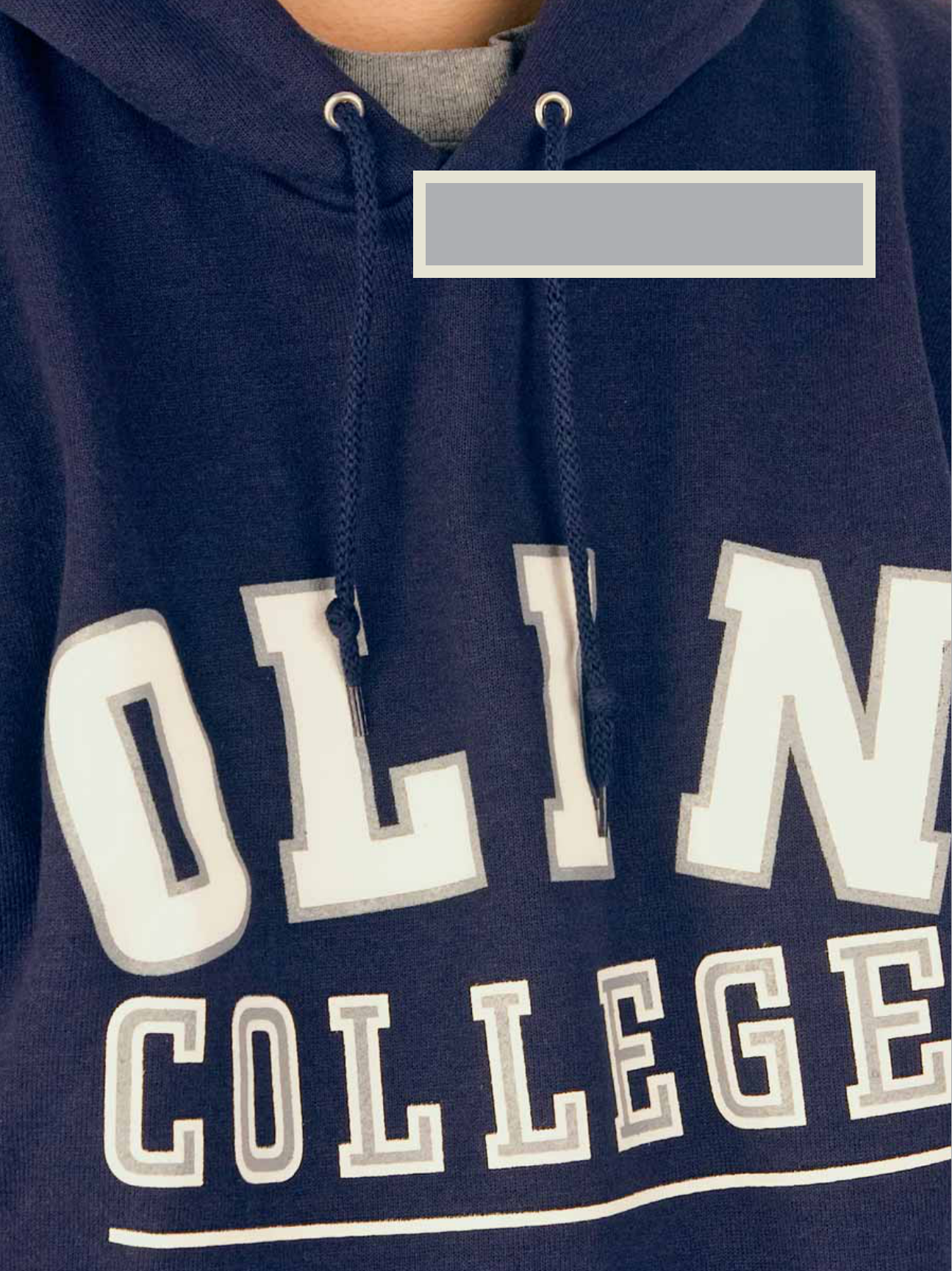
FROM THE GROUND UP THE FOUNDING AND EARLY HISTORY OF THE FRANKLIN W. OLIN COLLEGE OF ENGINEERING
Table Of Contents
1 Preamble
3 Founding Inspiration: Franklin W. Olin
6 The F. W. Olin Foundation
10 The Big Idea
19 The-Less-Than-Once-in-a-Lifetime-Opportunity
27 Building the Plane As It’s Flying
31 Needham: America’s Newest College Town
34 What’s Next?
37 Afterword and Acknowledgments
38 Appendix A: Statement of Founding Precepts
41 Appendix B: Founding Faculty
42 Sources
45 Endnotes
Franklin W. Olin College of Engineering Olin Way Needham, Massachusetts www.olin.edu
From The Ground Up
The Founding and Early History of the Franklin W. Olin College of Engineering
A Bold Experiment in Engineering Education
This book has been printed on paper certified
by SmartWood to the Forest Stewardship
Council (FSC) standards, indicating the trees
are grown in responsibly managed forests.
The majority of the pulp is from eucalyptus
trees, which mature in six to eight years,
replenishing the forests quickly.
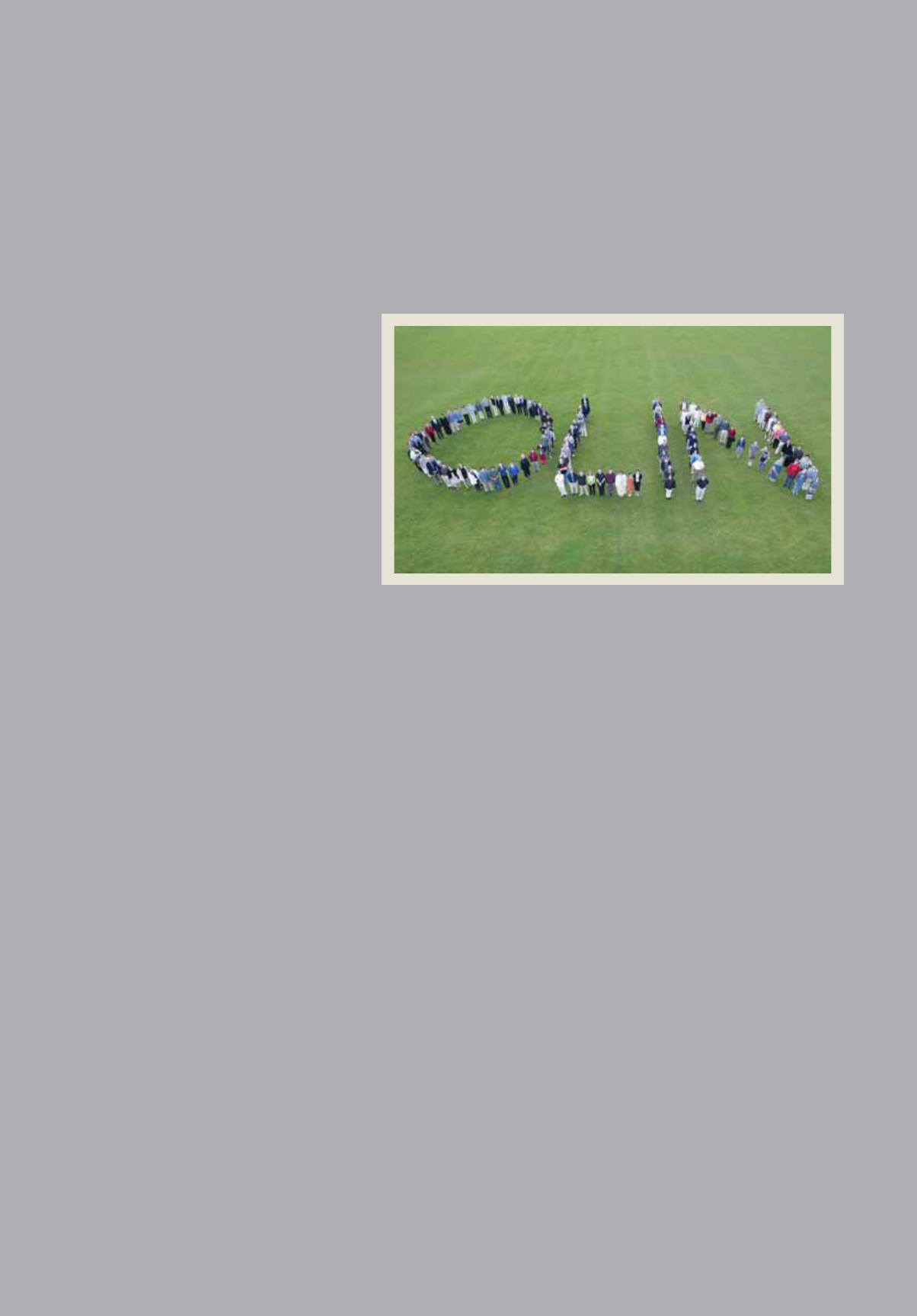
FROM THE GROUND UP THE FOUNDING AND EARLY HISTORY OF THE FRANKLIN W. OLIN COLLEGE OF ENGINEERING
Table Of Contents
1 Preamble
3 Founding Inspiration: Franklin W. Olin
6 The F. W. Olin Foundation
10 The Big Idea
19 The-Less-Than-Once-in-a-Lifetime-Opportunity
27 Building the Plane As It’s Flying
31 Needham: America’s Newest College Town
34 What’s Next?
37 Afterword and Acknowledgments
38 Appendix A: Statement of Founding Precepts
41 Appendix B: Founding Faculty
42 Sources
45 Endnotes
Franklin W. Olin College of Engineering Olin Way Needham, Massachusetts www.olin.edu
From The Ground Up
The Founding and Early History of the Franklin W. Olin College of Engineering
A Bold Experiment in Engineering Education
This book has been printed on paper certified
by SmartWood to the Forest Stewardship
Council (FSC) standards, indicating the trees
are grown in responsibly managed forests.
The majority of the pulp is from eucalyptus
trees, which mature in six to eight years,
replenishing the forests quickly.

From The Ground Up
The Founding and Early History of the
Franklin W. Olin College of Engineering
A Bold Experiment in Engineering Education
A Bold Experiment in Engineering Education
By Gloria Polizzotti Greis, Needham Historical Society

Credits
Text
Gloria Polizzotti Greis, Needham Historical Society
Photography
All photographs by Michael Maloney, unless otherwise noted.
Pages 1-10, photos courtesy F. W. Olin Foundation, unless otherwise noted.
Page 12, photos of William Schmidt and William Norden, courtesy F.W. Olin Foundation.
Pages 18 and 36, photos by Mark Flannery.
Page 21, poster image, and page 28, tabloid image, courtesy North Charles Street Design.
Design
Sylvia Peretz, Peretz Design
© 2009, Franklin W. Olin College of Engineering. All rights reserved.

In May 2006, the Franklin W. Olin College of
Engineering graduated its first class of seniors.
This was a milestone not only for the students, but
also for everyone associated with the institution. In
a very short period of time, this very talented group
turned a wooded hillside into a respected educational
institution whose reputation and influence continue
to grow.
The focus of this brief history is the genesis of the
idea to create a new kind of engineering college and
its realization as a living institution. Institutional
histories typically look back on past triumphs.
With little history (so far!), and with characteristic
momentum, any discussion of Olin will look to the
future more than it does the past. So this is just a
short respite, a quick stop on what promises to be
a long and adventurous journey.
June 2009
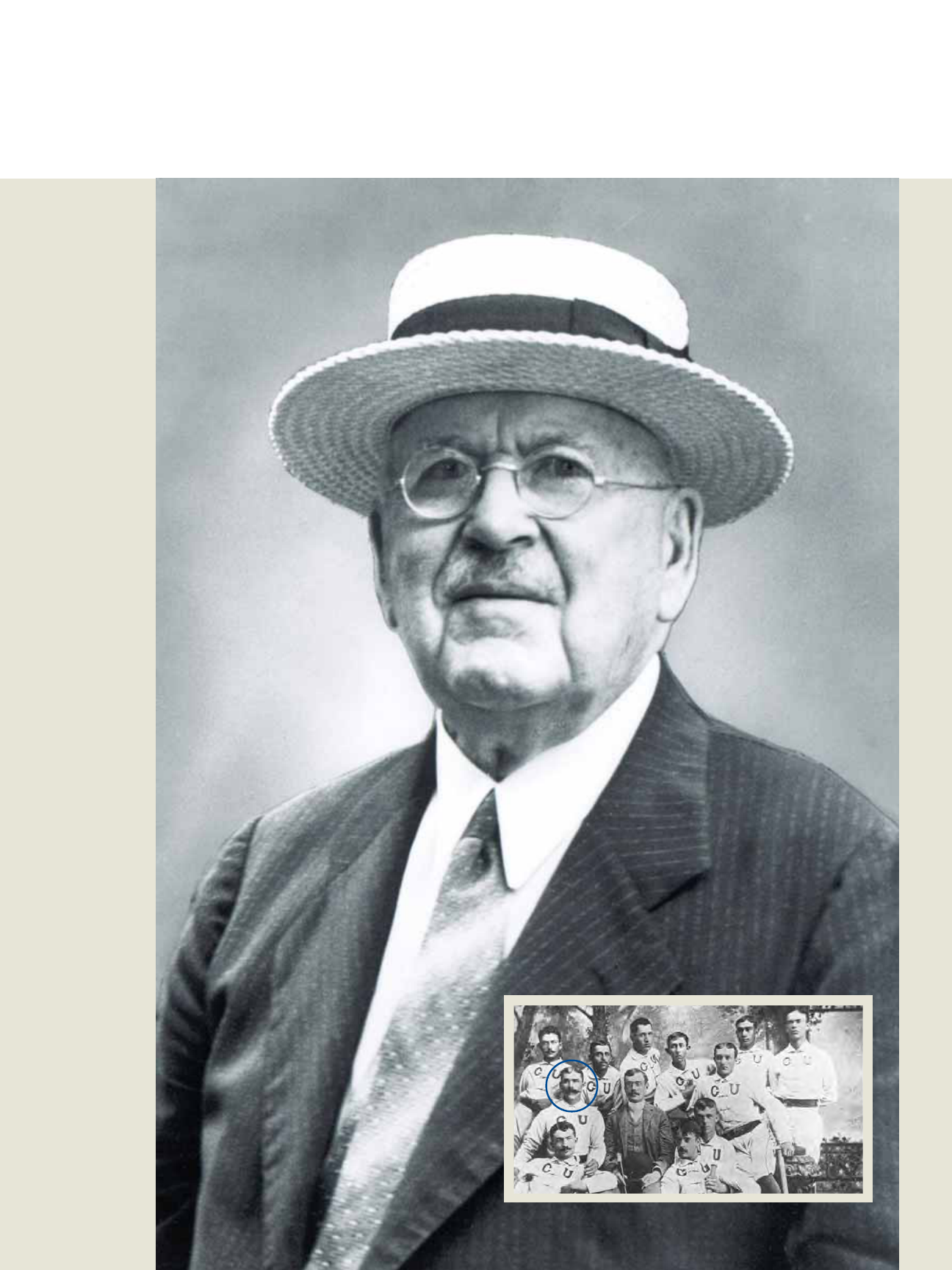
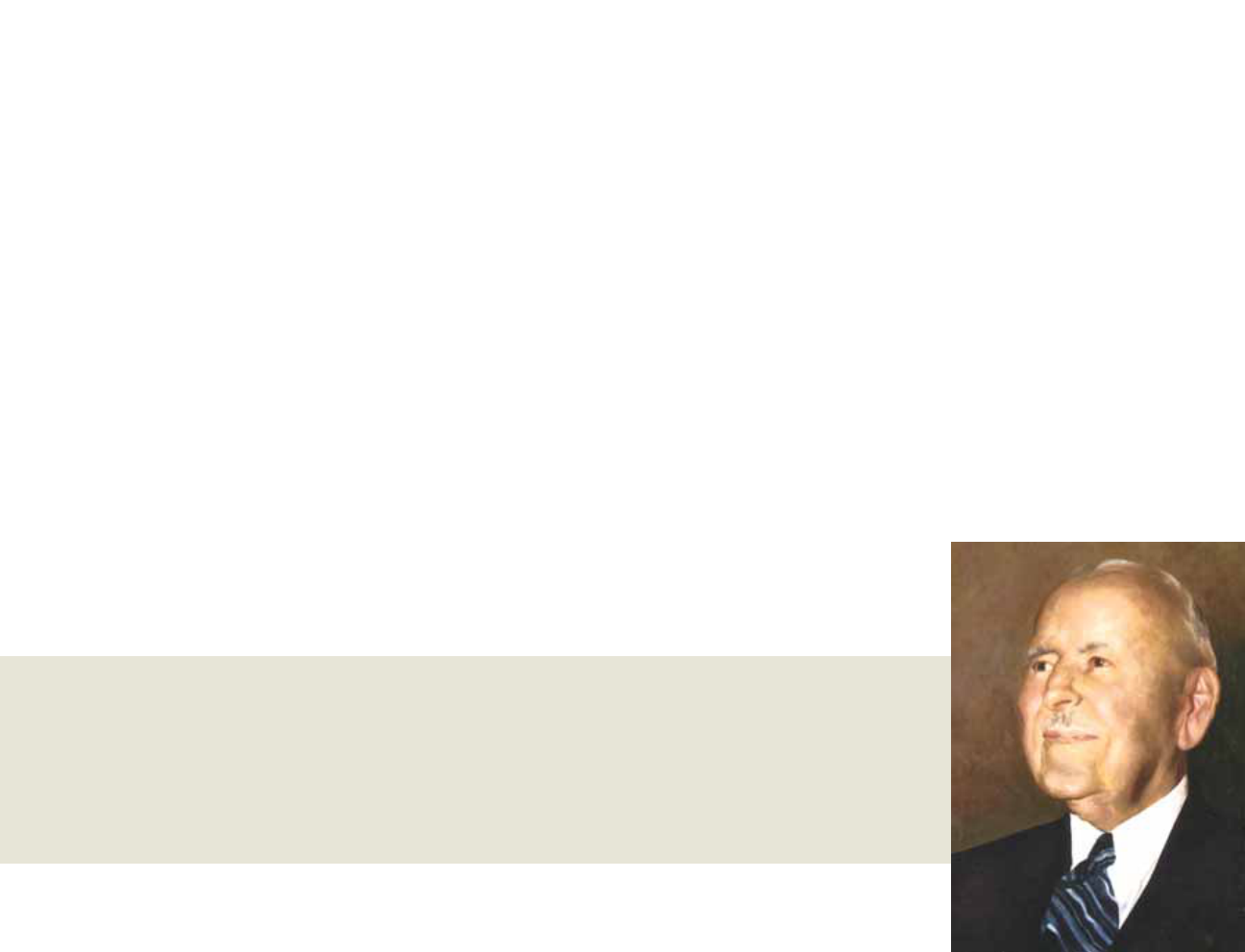
3
ranklin W. Olin’s life traced the arc of the
American legend. Born poor in rural Vermont
and largely self-educated, he retired as the head
of one of the country’s largest industrial corpora-
tions.
Olin was born in a lumber camp in rural
Woodford,Vt., in 1860. His father, Truman Olin,
was a master millwright who specialized in
building water wheels and other water-driven
machinery. As was common in those days, Olin
attended school until he was about 13, and then
went to work for his father. The family was then
living in Johnsonville, N.Y. (near Albany), where
Truman Olin was building the second-largest
water wheel in the world. At some point,
Franklin acquired a volume of the American
Machinist, replete with articles about the use
of steam to generate machine power. Since he
was already familiar with some aspects of power
generation, this was the inspiration that led him
to pursue an engineering education.
It took Olin the better part of five years to earn
both the knowledge and the money that a col-
lege education required. Secondary education
was scarce in rural communities. Instead, Olin
studied every book and article he could find that
would further his education, and even taught in
the local schools for a number of years to
increase his supply of books. Part of his time was
spent as a repairman, learning how machines
worked and how to fix them.
Olin was 22 years old when
he finally took the entrance
exam and was able to enroll
at Cornell University, where
he had two passions —
engineering and baseball.
Olin already had some experience playing local
ball before he reached Cornell. He was also older
and more muscular than most of his teammates,
and was made team captain in his freshman year.
His first challenge was to improve his team’s
lackluster hitting skills, which he accomplished
by introducing an indoor batting cage and
drilling his team relentlessly. The work paid off,
as the Cornell team became the Ivy League’s
most feared batters and consistent champions.
Olin also perfected the design of a concave bat
that gave him better contact, especially when hit-
ting curveballs. (See sidebar, “More on Olin’s Curved
Bat,” page 4.) This was legal in Olin’s day — the
size and shape of bats were not regulated, other
than the requirement that they have no more
than one flat side. His 540-foot home run, which
cleared the outfield and smashed into the foun
tain
Founding Inspiration: Franklin W. Olin
Franklin Olin died in 1951 at the age of 91. The scope of his
long career was a mirror of American industrial development in
the Machine Age. He began working in an era of water-powered
mechanics, and lived to see the advent of atomic power.
3
Franklin W. Olin;
Olin and his
Cornell University
teammates.
Photos courtesy
Cornell University
F
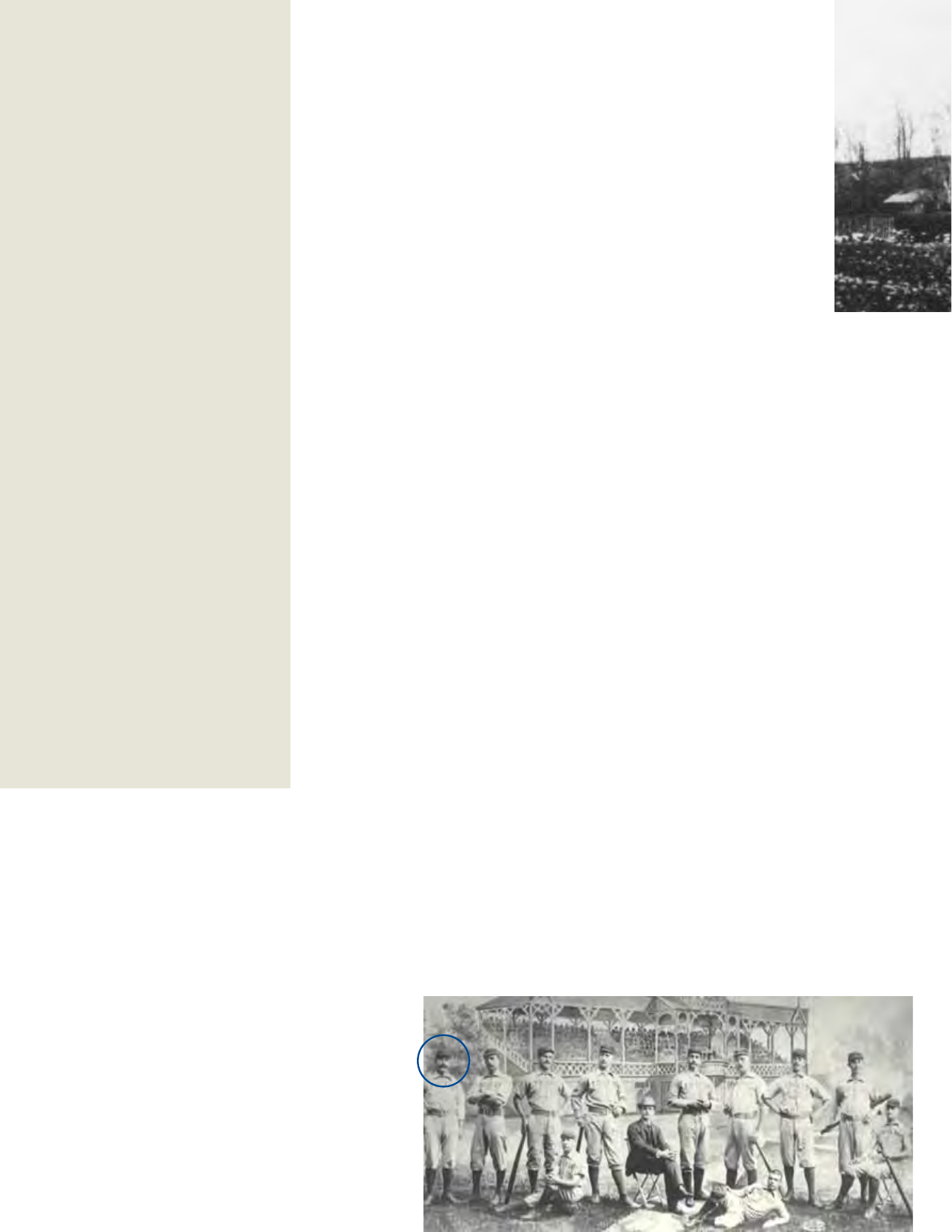
4
of Sage Chapel,
still stands as a
Cornell record —
an impressive
achievement, even
in these live-ball
days.
To earn money in
the summer, Olin
played professional
ball (also legal in
those days). He
was a left-handed
hitter and hit for
average rather than
power. Olin’s most
successful season in
the major leagues
was 1884, when
he played for the
Toledo Blue
Stockings and
the Washington
Nationals of
the American
Association, hit-
ting .312 in 48 games. His career average was
.316. Graduation in 1886 ended Olin’s baseball
career, though he remained a life-long fan.
Opportunities for civil engineers were rich in the
1880s, but it seems Olin was determined to work
for himself. He got his big break in the late
1880s when Olin Scott, a cousin, asked him to
take over supervision of the construction of a
new black-powder mill in New Jersey. Olin
would build several powder mills under con-
tract in the following few years. In 1889, Olin
married Mary Mott Moulton of Toledo, Ohio;
they eventually had three sons — Franklin Jr.,
Spencer and John.
By 1892, Olin had collected enough money and
experience to set up in business for himself. He
purchased a plot of land in the village of East
Alton, Ill., and using his own funds and invest-
ments from friends, he opened his first business,
the Equitable Powder Manufacturing Company.
This was a logical place to start; Olin had
acquired most of his professional experience in
the powder industry, and black powder was a
product whose market was strong and likely to
increase. It was the preferred industrial explosive,
especially in the rapidly growing coal mining
industry.
Equitable was the first of at least a dozen compa-
nies Olin would originate or acquire. Branching
out from powder production, Olin began to
develop plans for an ammunition plant and
opened the Western Cartridge Company in
1898. In succeeding years, he would enter
into all aspects of the ammunition business —
powder, shells, casings, lead shot and firearms.
Olin grew his businesses by having a focus on
quality and innovation.When a solution to a
particular problem was not available, he would
engineer his own. He designed and fabricated a
machine to load powder into shells that could
handle two shells at once, doubling the speed
of production and thus reducing cost. He also
improved shell primer production tenfold.
Olin played for the Toledo Blue
Stockings and other major
league teams during his summer
breaks from college.
Olin’s first factory in East Alton, Ill., housed
the Equitable Powder Manufacturing
Company, founded in 1892.
Before he became a philanthropic
powerhouse, F. W. Olin was known for
his skills on the baseball field, where
his inventive side was in evidence: he
designed [Cornell] University’s first
batting cage — one of the first indoor
batting cages — and came up with a
unique curved baseball bat.
Carved from a wagon tongue, the bat
was similar to others then in use —
with one important difference. When
presented with a curve ball, the batter
turned the bat a quarter-turn to reveal a
distinct concavity. The bat is mentioned
several times in baseball literature and is
described by Morris Bishop in his History
of Cornell: “convex on one side for dis-
tance, concave on the other to meet the
drop curves.” Apparently Olin was having
a hard time hitting the curve, and he
theorized that a bent bat would com-
pensate for the motion of the ball. It’s
not documented if and when Olin used
it, but it would have been perfectly legal
in major league play.
— Excerpt of article, “Bent Out of Shape:
Where
Is Olin’s Curved Bat?” by Stephen
Eschenbach,
in Cornell Alumni Magazine.
Used with permission.
More on Olin’s
Curved Bat
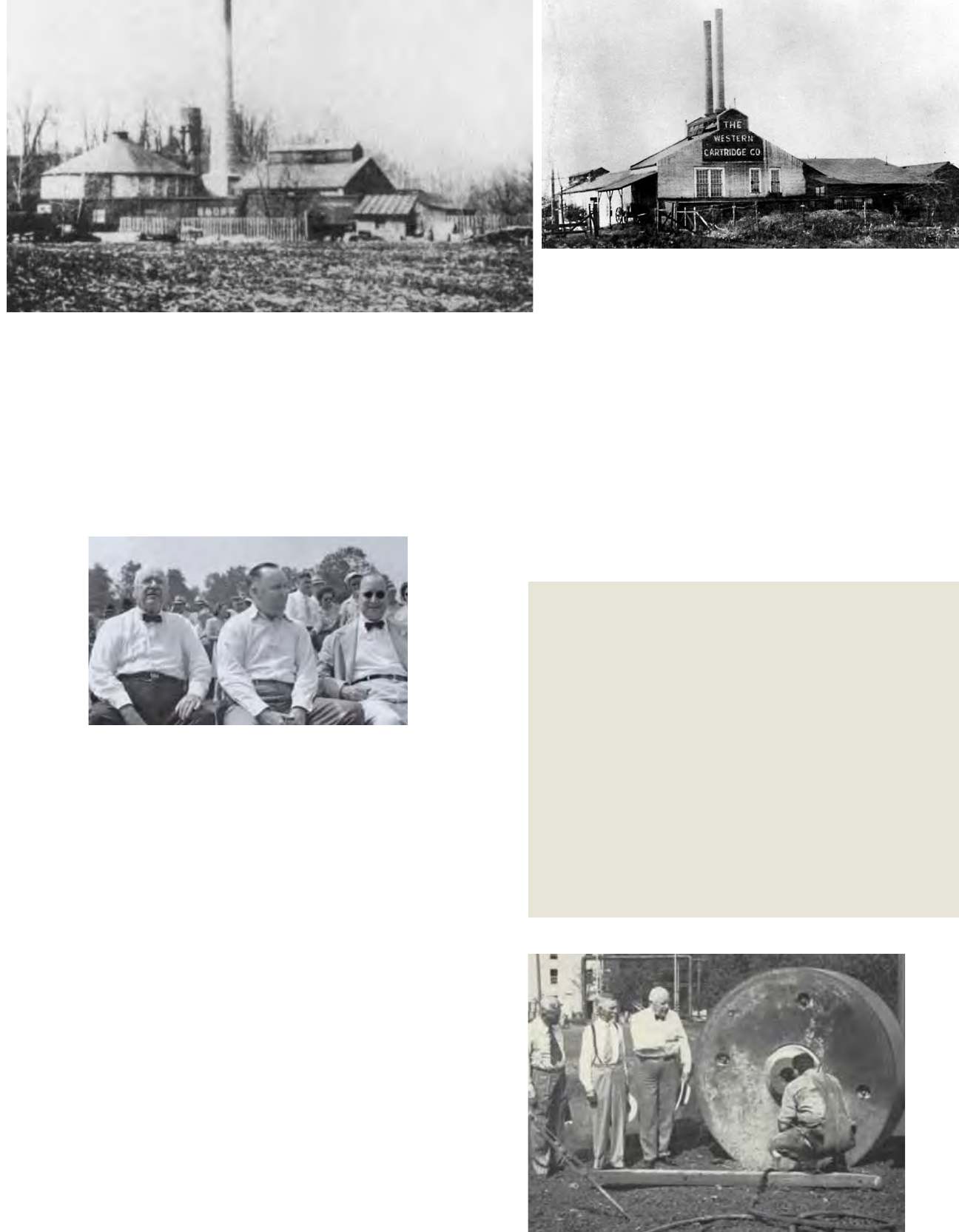
5
The companies’ capacity for large-scale produc-
tion was rewarded by large military contracts
in both World Wars. Olin’s companies supplied
nearly seven billion loaded rounds during World
War I — enough when laid end to end to circle
the equator 18.5 times. In World War II, he
produced more than 15 billion rounds. By the
war’s end,
Olin’s
companies
employed
more than
62,000
people.
Franklin
Olin finally
retired in
1944, at the age of 84. The various Olin compa-
nies were consolidated into a single entity, Olin
Industries, and passed into the hands of his sons
John M. and Spencer T. Olin. Both had followed
their father to Cornell and then into engineer-
ing. Both had been employed in various divisions
of the company throughout their careers.
Franklin Olin died in 1951 at the age of 91.
The scope of his long career was a mirror of
American industrial development in the Machine
Age. He began working in an era of water-
powered mechanics, and lived to see the advent
of atomic power. He displayed the inventiveness
characteristic of a generation of engineers for
whom all solutions were designed from scratch
but displayed a business sense that valued effi-
ciency, innovation and practicality in these
solutions as much as he did effective design. In
this way, Olin embodied the characteristics that
would be enshrined in the Founding Precepts
of the college that now bears his name.
The original Western Cartridge Company building
in East Alton, Ill.
Photos courtesy Olin Corporation
Franklin W. Olin (left) and his sons Spencer and John.
For the war effort, Olin donated the original
grinding wheels from the Equitable Powder
factory to the U.S. government for scrap metal
in 1944.
Although Charles Horn was a longtime associate of Franklin
Olin, his son, former Olin College Trustee William Horn, never
had an opportunity to meet the man himself. He did occasion-
ally speak to him on the phone, however, when the old man
would call to speak to his father.
Horn was impressed that Olin always remembered his name —
a boy of eight or nine did not expect that kind of attention
from a man as important as Mr. Olin. Olin would also never
fail to ask how young William was doing in school. If he could
report that he was on the Honor Roll, Olin would send him a
quarter — a pretty decent tip in those days.
The 25-Cent Reward
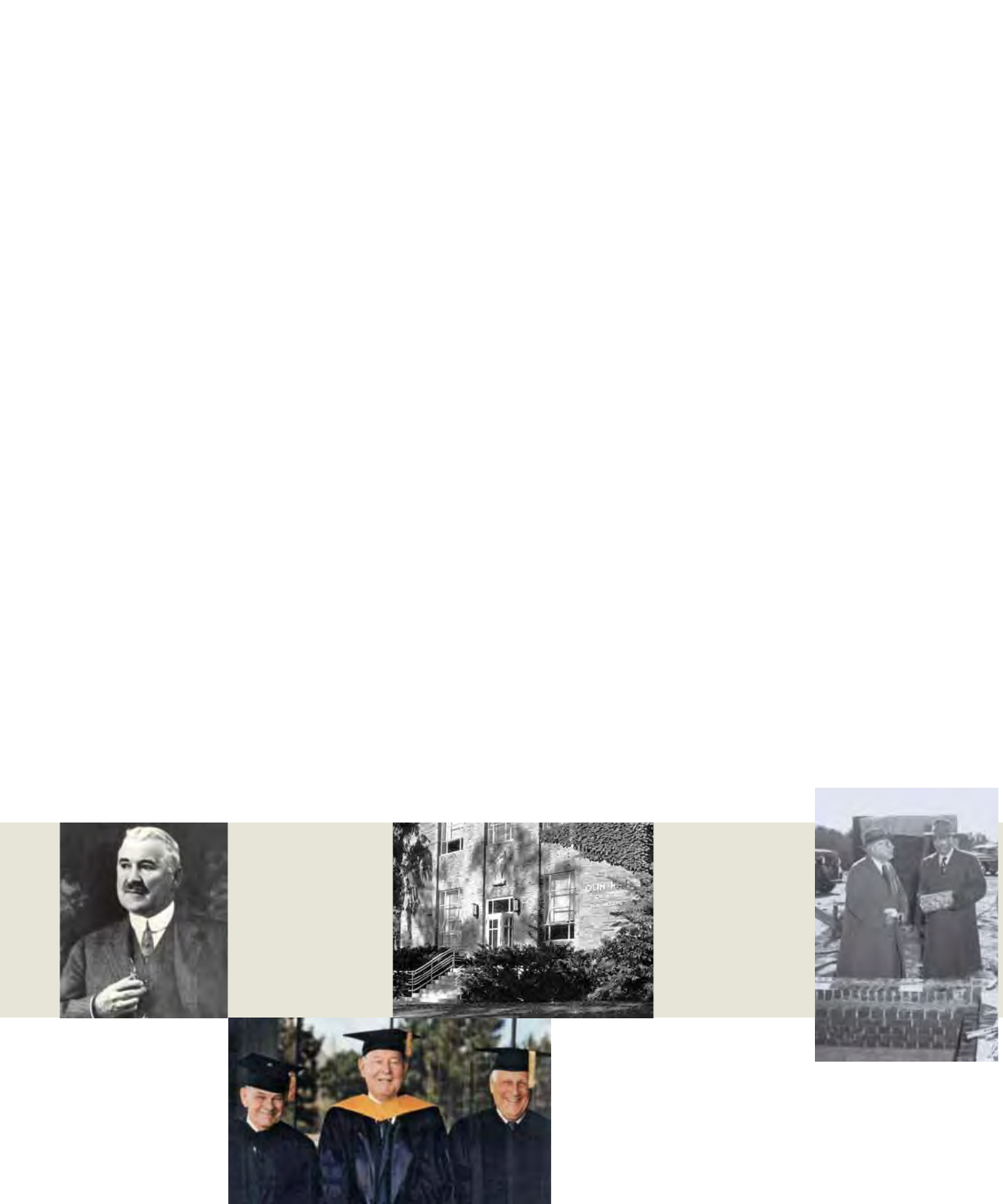
6
ranklin Olin set up the Olin Foundation, Inc.,
in 1938, transferring a significant portion of
his personal wealth, including his majority share
of the Olin Industries stock and ownership of
Federal Cartridge Company of Minnesota, one
of his subsidiary companies:
“Franklin Olin had finally turned the presidency
[of Olin Industries] over to John... . Franklin got
the bulk of the stock, and the boys [John and
Spencer] split the rest. The old man then took his
marbles out of the game....He plunked his stock
into a charitable foundation.... If the boys did
not want control of the company to pass to the
foundation on his death, they’d jolly well have to
hustle up the money to buy back the shares.”
1
They did, leaving the foundation some $50 mil-
lion with which to play Santa. The foundation
was managed by James O.Wynn, a New York
tax attorney who had helped Olin set up the
foundation; Charles L. Horn of Minneapolis,
president of Federal Cartridge; and Ralph Clark
of Alton, Ill., Olin’s financial consultant.
Olin did not articulate a strict policy for govern-
ing the choice of grant recipients, and the giving
priorities of the foundation were determined
primarily by the personal interests of Olin and
his wife. Donations were generally smaller gifts
to hospitals, churches, schools and community
organizations. There were, however, two major
gifts made by Olin. The first, in 1940, was a
gift of nearly $1 million to build Olin Hall of
Chemical Engineering at Cornell University.
Cornell was the alma mater of Olin and all three
of his sons; the building was named in honor of
the eldest son, Franklin Jr., who had died as a
The F. W. Olin Foundation
1938
Franklin W. Olin forms
F. W. Olin Foundation.
1940
First major building
grant, to Cornell
University, Olin’s
alma mater.
Directors James O. Wynn (joined the board in 1938),
Charles L. Horn (joined in 1946) and Ralph Clark
(joined in 1948), known as “the Three Musketeers,”
provided the foundation’s direction after Olin’s death.
F
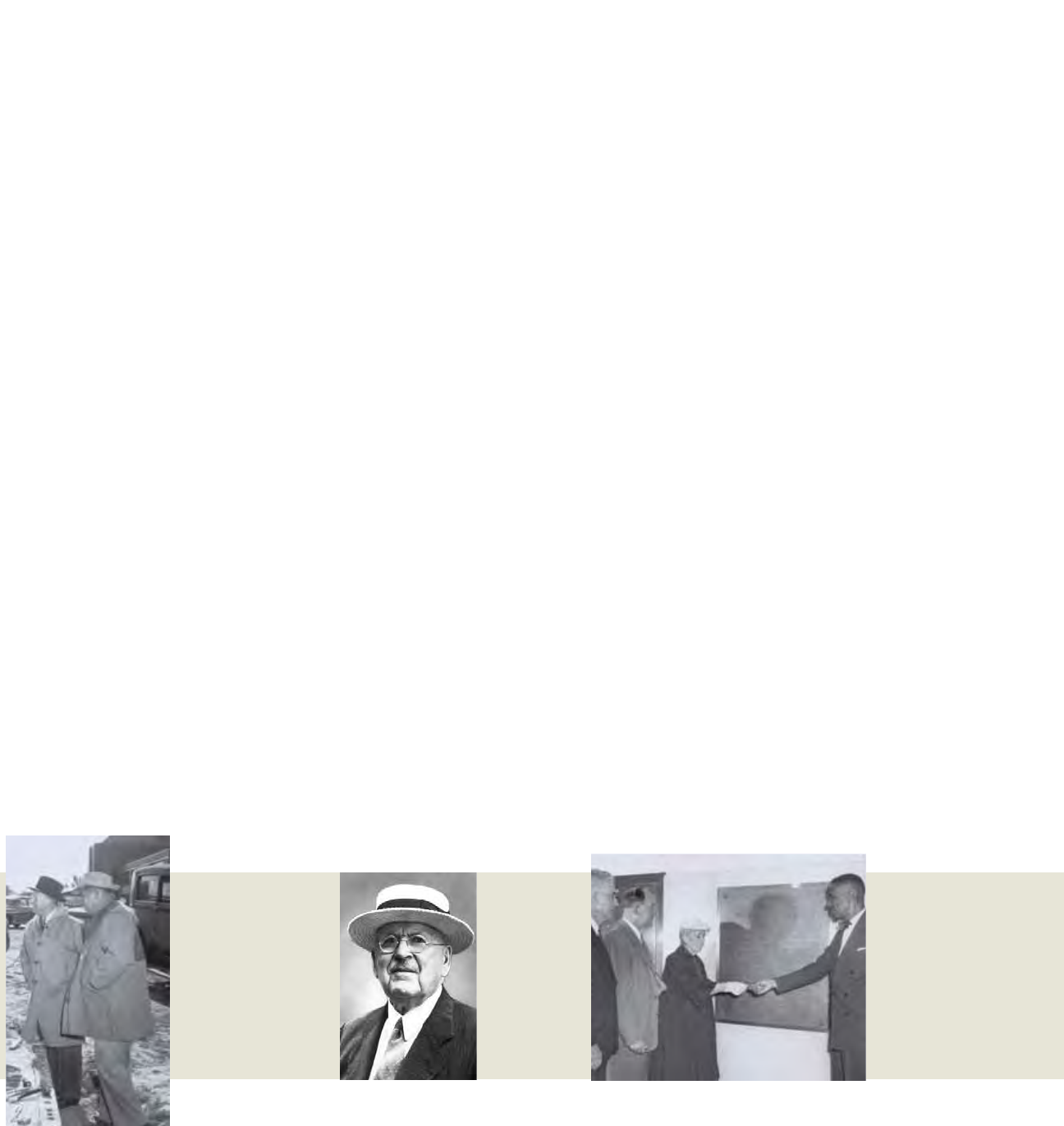
7
young man. The second major gift was a grant in
1949 to build and equip a vocational high school
in Olin’s adopted hometown of Alton. In found-
ing the school, he stated in justification: “I don’t
want the youth of the present generation to
encounter the same difficulties in obtaining a
useful education that I had to overcome when
I was a boy.”
2
After Olin’s death in 1951, it fell to the three
directors — Wynn, Horn and Clark — to estab-
lish the future direction of the foundation. Olin
had left neither specific instructions nor a formal
statement of mission to clarify his long-term
intentions, so in going forward, the directors
chose to be guided by Olin’s two major gifts,
to Cornell and to the city of Alton.
The grant process evolved throughout the 1950s.
Grants were made to colleges and universities, as
well as to a variety of other causes — a clinic in
Florida named for Olin’s wife, Mary; a school for
children with cerebral palsy in New Jersey; and
a building for the American Farm School in
Salonica, Greece. There were two additional
grants for vocational schools, one in Atlanta, Ga.,
and one in Birmingham, Ala., which were
required by charter to remain racially integrated
and offer equal access to white and African-
American students:
“While the Directors of the Foundation were
certain that the southern states had made far
greater progress in the education of the Negro
than was generally believed, they felt that educa-
tion was not always [wise] in the sense that we
have waved the flag and said everyone can be
President of the United States and then handed
the Negro adolescent, ranging from brilliance
down to mediocrity, a high school diploma with
an economic opportunity equal in many cases to
zero. In Atlanta and Birmingham, we found local
industry surprisingly enthusiastic about the idea
of vocational training on the high school level for
Negro youth. The Foundation therefore built and
equipped in these cities vocational high schools
which by the terms of the contracts with the
Foundation will at all times be open to members
of the Negro race.”
3
By the late 1950s the parameters of the educa-
tional building grant program were clear. The
grant recipients were private colleges, which did
not have ready access to public funding and had
to rely on private fundraising to effect capital
1949
Second major gift,
to the town of
Alton, Ill., to build a
vocational school.
1951
Olin dies.
1950s
Grants made in
many locations:
Florida, New Jersey,
Greece, Georgia,
Alabama.
improvements. If a grant was made, the award
included sufficient funds not only to build the
building, but also to fully furnish and equip it so
that it would be ready for use on the day it
opened. The focus of these grants was for the
most part science and engineering buildings, but
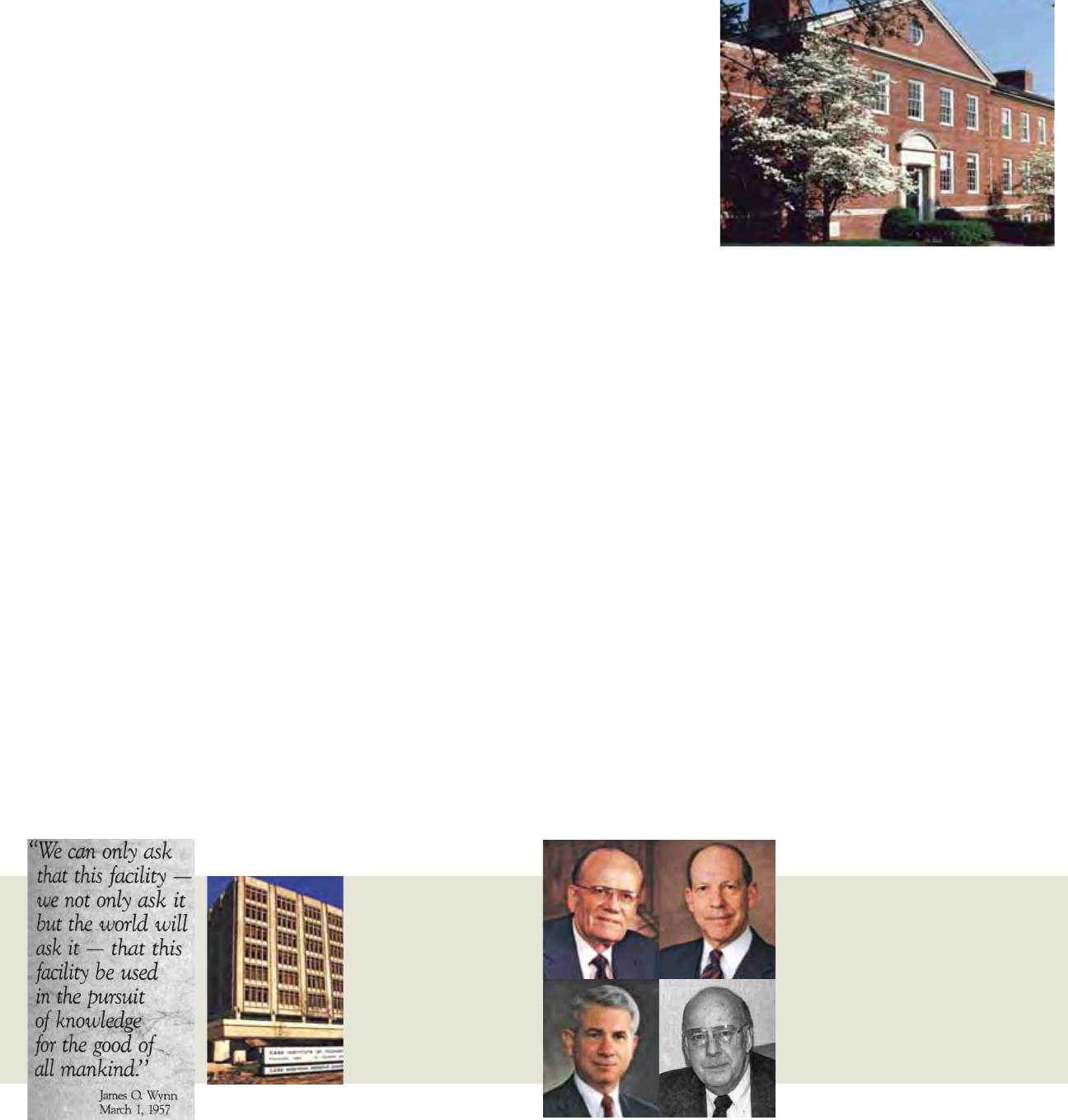
8
other facilities (libraries, art and performance
centers) were also funded. Although large colleges
were numbered among the grant recipients, many
were small regional schools, generally chosen
because of some demonstrated excellence in their
particular niche. The choice of grant recipients
was also somewhat remarkable for the progressive
scope of the directors’ vision — grants to sectari-
an schools of all denominations and historically
minority colleges made up a significant propor-
tion of the gifts.
Because the grants were for the entire facility,
from the physical structure to the chairs and light
bulbs, individual grants were quite large, and
there were only two or three grants in most
years. This had two ramifications, and the first
was simply pragmatic. The directors ran the
foundation themselves rather than hiring a staff,
but their own time was limited — while Clark
was able to dedicate his time more or less fully
to the foundation,Wynn and Horn still had other
professional commitments. By managing the trust
themselves, they maintained tight control over
the priorities of the foundation and one of the
lowest cost-to-grant structures of any American
foundation.
The other advantage of a
large-grant program, apart
from its administrative efficiency, was the impact
that it could have. Grants on such a scale could
transform institutions by filling longstanding
needs, freeing up capital for additional expansion
and — most important — acting as a catalyst
to energize additional capital fundraising. For
smaller private colleges, especially those that his-
torically served a minority or sectarian commu-
nity and did not have a strong fundraising history,
an Olin grant validated the college’s mission,
gave luster to its reputation, and energized its
alumni and supporters. Olin grants were often
announced as the centerpiece of or kickoff to a
larger fundraising campaign.
This grant pattern was well-established by the
1960s. As college expansion accelerated in the
wake of Sputnik and the race to the moon, appli-
cations for foundation grants soared as well. The
Agenda of Applicants, the roster of grants under
consideration, grew to hold several hundred
requests. Given the rate of disbursement (two or
three per year) and the personal involvement of
the foundation directors in each grant, applica-
tions remained on the agenda for a long time.
Applicants could wait for years without
Early 1960s
Foundation solidifies
giving policies to focus
on building grants for
independent colleges
and universities.
1970s
New members added
to the board:
(clockwise from top left)
Carlton T. Helming, William
B. Horn, Robert D. Moss,
Lawrence W. Milas.
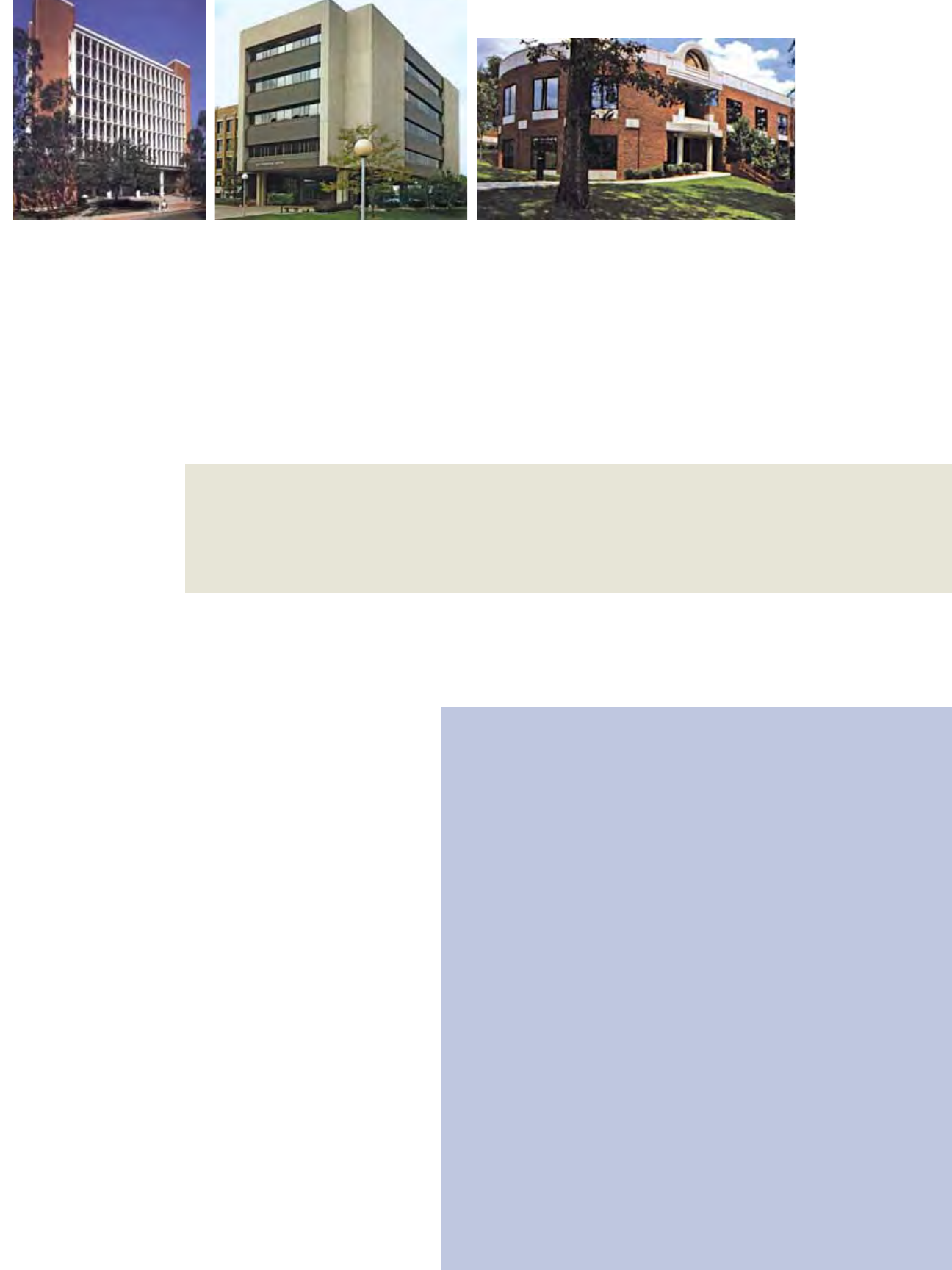
9
hearing anything about the progress of their
request, prompting one recipient to give to the
directors a plaque bearing the admonition: “No
News Does Not Mean No.”
By the mid-1970s, it was time for the Old Guard
to turn the foundation’s reins over to younger
hands. The original directors had managed the
foundation for more than 20 years; Charles Horn
was in his mid-80s, Ralph Clark was in his early
80s, and James Wynn was the young-
ster, in his late 70s. New members
were added to the board in 1974,
drawn as before from familiar Olin
sources — new directors Carlton
Helming, Robert Moss and William
Horn (Charles Horn’s son) were all
officers of Federal Cartridge, and
Lawrence Milas was the law partner
of James Wynn and legal advisor to
the foundation. A deliberate effort
was made in selecting these men to
maintain the continuity of the grant
program. In 1987, the foundation
formally changed its name from the
Olin Foundation to the F. W. Olin
Foundation, to be identified more
closely with its founder and clearly
distinguish it from other “Olin” foundations
established by his sons and others.
The new board maintained the grant program,
but streamlined the process for selection, ulti-
mately opting for a regular annual review and
notification cycle. Overall, from 1938 until 1997,
when the grant program was suspended, the
Olin Foundation funded the construction of 78
buildings at 58 different institutions.
Olin Foundation Building Grant Recipients
Augustana College
Albion College
Alfred University
Babson College
Bard College
Bates College
Birmingham-Southern College
Blackburn College
Bradley University
Bucknell University
Carleton College
Case Western Reserve University
Centre College
Clemson University
Colby College
Colgate University
Colorado College
Concordia College
Connecticut College
Cornell College
Cornell University
Denison University
DePauw University
Drake University
Drury College
Florida Institute of Technology
Franklin W. Olin College of Engineering
Gustavus Adolphus College
Hampton University
Harvey Mudd College
Jarvis Christian College
Johns Hopkins University
Kenyon College
Lafayette College
Lewis & Clark College
Luther College
Macalester College
Marquette University
Millsaps College
Mills College
Nebraska Wesleyan University
Roanoke College
Rollins College
Rose-Hulman Institute of Technology
Southwestern University
Tufts University
Union College
University of Denver
University of San Diego
University of Southern California
Ursinus College
Vanderbilt University
Wake Forest University
Washington & Jefferson College
Whitman College
Willamette University
Wofford College
Worcester Polytechnic Institute
Worcester Polytechnic Institute (1957), University of Southern California (1964), Marquette University (1975) and
Birmingham-Southern College (1984) buildings.
Large Grants could transform institutions by filling longstanding needs,
freeing up capital for additional expansion and — most important — acting as
a catalyst to energize additional capital fundraising.
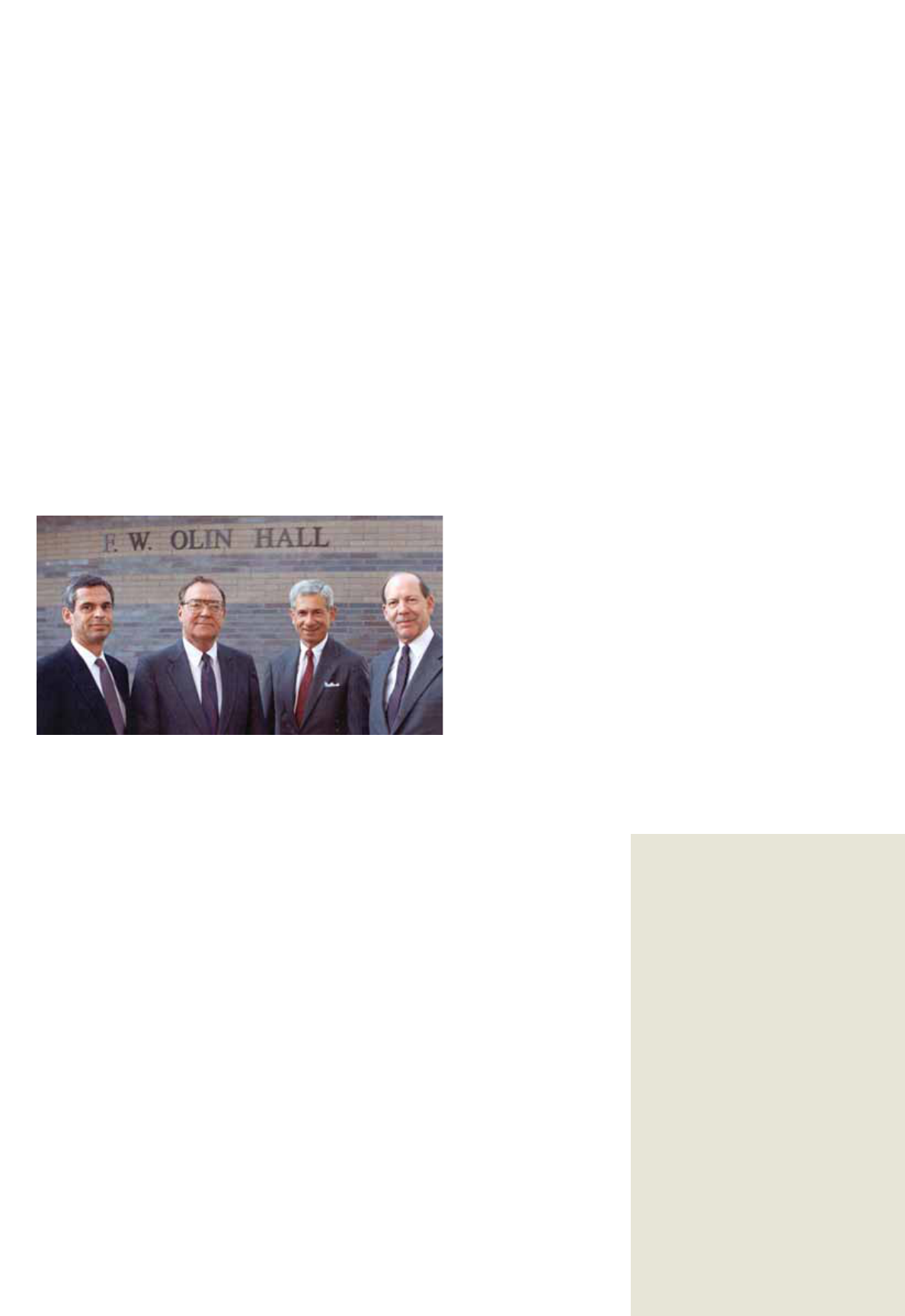
10
The Big Idea
here was another board transition in the
1980s. Helming and Moss passed away;
William Norden, a lawyer in Wynn and Milas’
firm, took over as legal counsel and joined the
board, as did William Schmidt, another former
officer of Federal Cartridge. For the first time,
there was no board member who had a personal
acquaintance with Franklin Olin. The closest
connection was William Horn, whose father,
Charles, had known Olin but who was not him-
self a colleague of the old man.
As governance of the foundation moved further
and further from the founding directors, the
problem of long-term planning and succession
began to loom. In the 30 years since Olin’s death,
the foundation had worked without a formal
written mandate, following a path determined
by the directors’ personal knowledge of Olin’s
intentions and their own expertise. The founda-
tion itself was run with a minimal staff and
maintained one of the lowest cost-to-grant ratios
of any foundation in the country. The directors
themselves evaluated the applications and con-
ducted the site visits. This thriftiness allowed
them to keep more money in the grant pool
and maximize the impact of each grant on the
recipient institution.
Nevertheless, as it looked forward to the next
30 or more years, the board could not expect to
continue in the same manner. All previous direc-
tors had come to the board because of their
professional services to the foundation or with
Federal Cartridge Company, an Olin subsidiary
that was owned by the foundation. However,
changes in federal tax laws required the founda-
tion to sell Federal Cartridge. Ownership of
Federal had been transferred to the foundation
when Olin first established it in 1938; it was the
foundation’s largest asset, and over the years its
profits had provided significant funds to support
the building grants program. The sale of Federal
Cartridge guaranteed
that future directors
would have to come
from outside the circle
of professional and
corporate affiliations
that had surrounded
Mr. Olin. The board’s
greatest concern was
that new directors,
with no connection to
the founding culture
that had guided the
foundation since its
Foundation Directors: William Norden, William Schmidt,
Lawrence Milas, William Horn.
In order to continue as
they thought appropri-
ate, the board would
have to come up with a
succession plan and
restrictions that would
limit future directors’
discretion and maintain
the foundation’s focus
on college buildings.
The other option was to
dissolve the foundation
and spend down its
resources.
T

11
inception, could take the foundation in a new
direction. To that point, the directors had care-
fully guarded a mission that they thought best
reflected the intentions of Franklin Olin.
By the early 1990s, the problem of strategic plan-
ning for the future became acute, and the board
was faced with the decision whether to continue
or dissolve. In order to continue as they thought
appropriate, the board would have to come up
with a succession plan and restrictions that would
limit future directors’ discretion and maintain
the foundation’s focus on college buildings. The
other option was to dissolve the foundation and
spend down its resources, either by choosing two
or three very large projects or by dividing the
money among the 50 or so Olin grant colleges
to finance building upgrades or new construc-
tion. Such a project, however, would take years
and require a large staff to administer.
The task fell to Milas, who had been president
of the foundation since 1983, to lead the effort
to consider the advantages and disadvantages of
the various options and make a recommendation
to the board. If there is one person who can be
called the founder of Olin College, it is Milas.
His advocacy of the idea of establishing the
college and his involvement in its development
are the reasons the college exists today.
However, as Milas initially sat down to review
his options, the way forward for the foundation
was not at all clear. The solution had to not only
be one that advanced the foundation’s purpose to
best advantage, but one that also would create the
greatest possible impact for its resources. In keep-
ing with long-standing Olin Foundation priori-
ties, the solution should focus on education and
engineering. Milas was considering collaborations
with various types of institutions; each possibility
had its strengths and weaknesses, but none really
fit what he was trying to accomplish. It was
Milas’ wife, Marjorie, who finally provided the
inspiration. After putting up with her husband’s
mumbling and pacing around the house, she
finally observed, in jest: “Why don’t you just start
your own damn college?” Milas’ first thought
was,“You’d
have to be
crazy.”
4
On second
thought…as
a solution to
the problem, it
covered all the bases — and it certainly had
impact. Milas thought it over carefully and
worked on it for several months before bringing
the idea to the board in the fall of 1993.
It is probably safe to say that Milas’ report took
the directors by surprise. Entirely bypassing
succession plans and the distribution of building
funds, Milas proposed three bold new scenarios:
give the entire sum to a smaller but well-regarded
engineering school and use the money to raise it
to the top tier; use the money to start an engi-
neering school at a well-regarded institution that
did not have one; or the most costly and daring
option, start a whole new school from the
ground up.
The board’s reaction was decidedly mixed. The
proposals, especially the latter, would give the
foundation a great deal of publicity and make a
huge impact on engineering education. But it
was also a complex and uncertain undertaking
that could result in nothing more than a well-
publicized failure that compromised the founda-
tion’s reputation as well as its assets. Nevertheless,
the board gave Milas the approval to explore it
further.
“Why don’t you just start
your own damn college?”
— Marjorie Milas
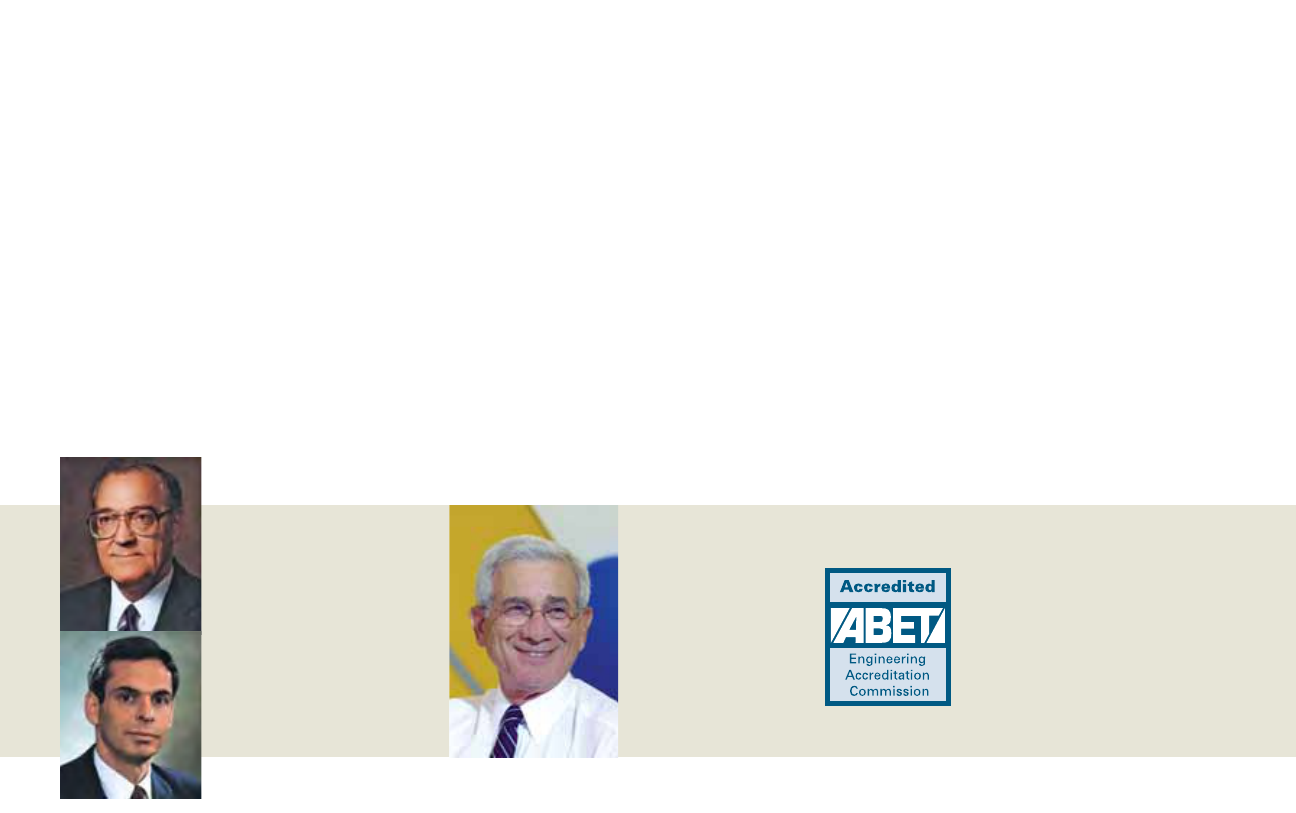
12
To make matters more complicated, as the
directors deliberated the future of the Olin
Foundation, engineering careers in America were
at a low point. The Cold War was, if nothing else,
a boon to American engineering; government
funding and Defense Department contracts had
fueled huge advances in technology for over 40
years. Shifts in funding after the collapse of the
Soviet Union led to a soft employment market
for engineers and a drop in the demand for
engineering degrees. In response, the National
Science Foundation (NSF) and American busi-
nesses took aim at this same issue — looking to
retool engineering education in the same way
that the engineering profession was trying to
retool itself. In the view of the NSF, engineering
education had become too specialized, leading to
engineers with excellent technical skills but none
of the other skills that they needed to succeed in
the new, more business-oriented environment
that was taking shape. Many engineers’ careers
would stagnate after a few years, because they did
not have the communication or teamwork skills
the needed to advance as managers and their
expertise was too narrow for them to effectively
communicate within the company or with
clients or partners. In the words of Marshall Lih,
director of the NSF’s Division of Engineering
Education, most schools were educating engi-
neers to be bricklayers rather than cathedral
builders.
5
Engineers needed teamwork and com-
munication skills, especially for teams that includ-
ed non-engineering specialists. As businesses
became more global in their focus, it would be
necessary for engineers, like other professionals,
to communicate effectively across cultural lines.
To succeed in this new environment, they would
also need to be creative, think like entrepreneurs
and possess excellent design skills.
The requirements of business and the changes
championed by the NSF were adopted by
the Accreditation Board for Engineering and
Technology (ABET) in its “Criteria 2000,” a
revised rubric for the accreditation of engineer-
ing education institutions. According to these
criteria, engineers of the future should possess:
• the ability to apply knowledge of math,
science and engineering
• the ability to design and conduct experi-
ments, and analyze and interpret data
• the ability to design a system, component
or process to meet a desired need
• the ability to function on multidisciplinary
teams
• the ability to identify, formulate and solve
engineering problems
1980s
William Schmidt and
William Norden join
board as directors.
Federal Cartridge
Company sold.
1993
Milas proposes
new college
idea to the
board.
Late 1990s
ABET adopts Criteria 2000
guidelines for accreditation
of engineering education
institutions.

13
• an understanding of ethical and professional
responsibility
• the ability to communicate effectively
• the broad education to understand the
impact of engineering solutions in a global
and societal context
• a recognition of the need for, and the ability
to engage in, lifelong learning
• a knowledge of contemporary issues
• the ability to use the techniques, skills and
modern engineering tools necessary for
engineering practice
More than half of these 11 criteria addressed
nontechnical requirements that were typically
outside the scope of an engineer’s training.
6
Given the decline in the demand for engineering
degrees, why did the Olin Foundation think that
the country needed another engineering school?
Milas’ response — echoed by ABET, the NSF
and American business — was that the country
did not need another engineering school, it
needed a different one. Although some engineer-
ing schools were seeking to implement changes
in the way their students were taught, many did
not see the need for such change. By the NSF’s
estimates, more than 50 percent of engineering
students dropped out of the program by their
sophomore year, and the demand for engineering
degrees had declined by 20 percent since 1985,
despite the strong and technologically-focused
economy. Nevertheless, less than 25
percent of the faculties of the nation’s 300 engi-
neering institutions saw a need to overhaul their
curricula.
7
Established schools had entrenched
institutional cultures, interdepartmental competi-
tion for resources and funding, a defined faculty
structure, and established research and funding
relationships that could not simply be jettisoned.
Progress, when it came, could only be slow and
incremental.
The Olin Foundation directors debated their
options in the light of what they had learned in
their consultations with educators, businesses and
organizations like the NSF and ABET. Their
many years of reviewing grant applications and
meeting with more than 100 college representa-
tives annually had given the directors a strong
and thorough understanding of the strengths and
weaknesses of America’s higher education system.
Making over an existing school or endowing a
new school at an established institution had
similar limitations, and the potential to effect real
change in the way engineers were trained was
minimal. After several years of deliberation, the
foundation’s directors eventually decided that
their best option was to start a new school,
which could be a laboratory to test this new
1997
Olin Foundation receives charter
from Massachusetts Board of Higher
Education to establish Franklin W.
Olin College of Engineering.
2002
Foundation and Olin College adopt
a Statement of Founding Precepts.
Arrival of first freshman class,
which includes 30 Olin “partners”
who joined the college the year
before.

14
direction in engineering education unencum-
bered by the baggage of the past. Olin’s college
could be nimble, without an established faculty
or institutional culture, no territories to jealously
guard, no competing priorities, no burdens of
tradition. It could be set up from scratch with the
single focus of engineering excellence, with an
administration and faculty dedicated to perfecting
an engineering curriculum. By eliminating both
academic departments and faculty tenure, the
college could more easily craft an interdiscipli-
nary curriculum that could respond quickly to
changes in the engineering field.
The foundation chartered its college in 1997,
beginning the process that would eventually
dissolve the charitable institution in favor of the
new college. To ensure that the founder’s legacy
would be preserved and to distinguish this effort
from the endeavors of the other foundations that
bore the Olin name, the school was to be called
“the Franklin W. Olin College of Engineering.”
In October 1997, the foundation petitioned the
Massachusetts Board of Higher Education for
permission to organize the college and award
Bachelor of Science degrees in engineering, as
well as honorary doctorates in engineering, laws
and humane letters. The board’s approval was the
necessary first step in obtaining a charter from
the state. The process was not expected to be
easy, since much of the required documentation,
especially the curriculum plan, had yet to be
written. This could also be a
very slow process, often last-
ing as long as two years, but
none of the other plans could
go forward until the decision
had been rendered.
For an outline of the pro-
posed education program,
Milas sought the advice of
Dr. James Eifert, of Rose-Hulman Institute of
Technology in Indiana, then vice president for
academic affairs and later the founder of the
entrepreneurial Rose-Hulman Ventures program.
Rose-Hulman’s programs in engineering and
entrepreneurship were models for the type of
progressive and innovative education that the
Olin trustees wanted to offer. Eifert drafted a
curriculum outline that emphasized the impor-
tance of introducing opportunities for professional
practice alongside classroom training and allowed
considerable latitude for students to incorporate
personal interests and career goals into their
training.
In presenting their petition, the trustees outlined
an expansive vision of the role of engineering
training in professional and civic life, a vision that
was the first comprehensive statement of what
the new college would be. Olin-trained engi-
neers would be adequately prepared to build
anything and everything, from widgets to global
communities.
In the words of
Marshall Lih, director
of the NSF’s Division of
Engineering Education,
most schools were edu-
cating engineers to be
bricklayers rather than
cathedral builders.

15
The logistical portions of the petition outlined
Eifert’s plan for a curriculum of coursework in
mathematics, the sciences and engineering struc-
tured around a framework of professional men-
toring (including opportunities for professional
practice), experiential learning, and international
education and work experience. The curriculum
would be “vertically integrated,” allowing less-
experienced students to share projects with both
upperclassmen and faculty, as a means of engag-
ing their problem-solving capabilities and chal-
lenging their skills. For this to work well, the
college would have to attract the brightest and
most motivated students, and therefore the
trustees were eager to keep the financial and
institutional barriers as low as possible — tuition
for all students would be covered by a full schol-
arship, state-of-the-art equipment and resources
would be supplied, and the faculty-to-student
ratio would be low.
In order to keep the process on track, Milas
met with James Carlin, chairman of the
Massachusetts Board of Higher Education,
about the application. Carlin was intrigued by
the innovative nature of the Olin Foundation’s
proposal and encouraged the board’s staff to
expedite its review. Following a positive review,
the Board of Higher Education responded with
“speed, support and enthusiasm”
9
to Olin’s peti-
tion, approving the Articles of Organization and
the authority to award degrees within a few
weeks of their submission.
Following the approval of the articles came the
still harder work of crafting the college. The
powerful vision and program outlined in the
“We envision a 21st Century in which the industrial and commercial community is truly a global
marketplace....We believe that modern engineering education provides the optimum basic
preparation for the leaders of the future we see. We believe that engineers will continue to be
expected to practice their profession in the traditional technical capacities. In addition, however,
we believe that engineers will be called upon and must assert their leadership as managers of
technology-based commercial ventures and governmental agencies, as senior corporate leaders,
entrepreneurs, political leaders, and as specialized professionals in the fields of medicine and
law. We believe that engineers will be so important in this future society because their education
uniquely provides them with the essential knowledge, skills, processes and perspectives to
understand the complex system that modern life has become. Many educational programs
provide graduates with either the ‘know how,’ the ‘know why’ or the ‘know when.’ The Franklin W.
Olin College will enable its graduates to develop within themselves the necessary synthesis
of these three ingredients to emerge as the effective leaders needed to chart our course through
the future.
In short, we see a future in which an undergraduate engineering education becomes the true
‘Liberal Education,’ i.e. an education which liberates one to lead a personal and professional life
of full citizenship in one’s local, national and global communities.”
8
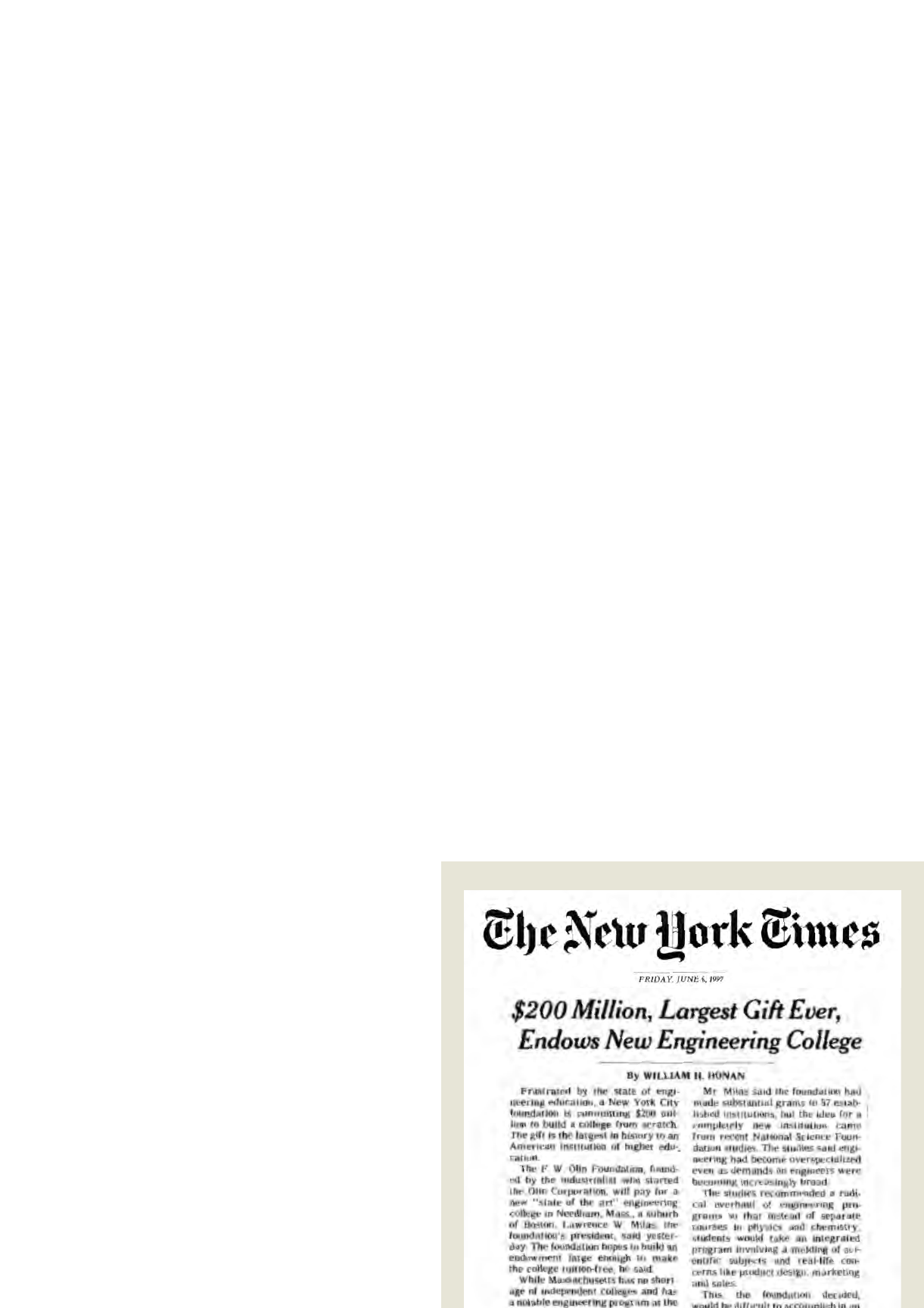
“Let it be said that the Foundation does not seek to establish a generic undergraduate engineer-
ing college — one that will simply offer programs similar to many others around the country.
Olin College is intended to be different — not for the mere sake of being different, but to be an
important and constant contributor to the advancement of engineering education in America
and throughout the world and, through its graduates, to do good for humankind.”
The precepts enshrined innovation in practice and pedagogy at the core of the college’s mission:
“Even a new institution can, with the passage of time, become resistant to change. If this were
to happen at the College it would be a tragic loss of opportunity for engineering education,
generally, and a terrible disappointment to the Foundation. The need for the College to be
continually open to change and to encourage and support a culture of innovation is paramount.
Risk-taking with respect to new programs or in the manner in which engineers are taught
should be routine. The College acknowledges that a culture of innovation is a fundamental
precept of the planning for Olin College.
The College commits itself to the need to
be open to change and to support a culture
of innovation and constant improvement
in every aspect of its operations and pro-
grams.”
16
charter documents became the starting point for
the school’s organizational structure. As the
trustees began to hire an administrative staff —
a president and deans — to implement this
vision, it became obvious that it would be
necessary to articulate a legal framework for the
commitment of the foundation’s assets to its new
college, and a contract that bound the staff to
pursue the foundation’s vision and expectations.
In the first few years, while they were occupied
with building the college, the trustees and
administration operated from a common set of
assumptions based on the founding vision articu-
lated in the charter and other documents.
Finally, in 2002, the foundation and the college
formally adopted a Statement of Founding
Precepts. The precepts codified the assumptions
and principles that inspired the founding of
the college and spelled out the foundation’s
philosophy of independence, innovation and
philanthropy:

17
The changes in engineering deemed necessary by
ABET and the NSF were acknowledged as the
framework for curriculum development:
• interdisciplinary and integrated teaching
• hands-on learning and research
opportunities
• improved communication skills
• students working in teams, similar to
industry practice
• exposure to other cultures or international
experiences
• a better understanding of business and
management practices
Most important, the Founding Precepts defined
Olin as “student-centered,” placing commitment
to the teaching of students, rather than the needs
of faculty, at the center of its endeavors. The
curriculum would address all aspects of students’
social and intellectual development, emphasizing
the arts and humanities as well as the sciences.
Furthermore, the foundation would promote
access for all qualified students by providing all
of them with full-tuition scholarships. Students
who choose to attend Olin College could do
so based on their evaluation of its educational
offerings, rather than on personal financial
circumstances. The overall goal was to gather as
diverse a body of students and faculty as possible.
Students would be chosen on the basis of aca-
demic merit and the breadth of their interests
and commitments.
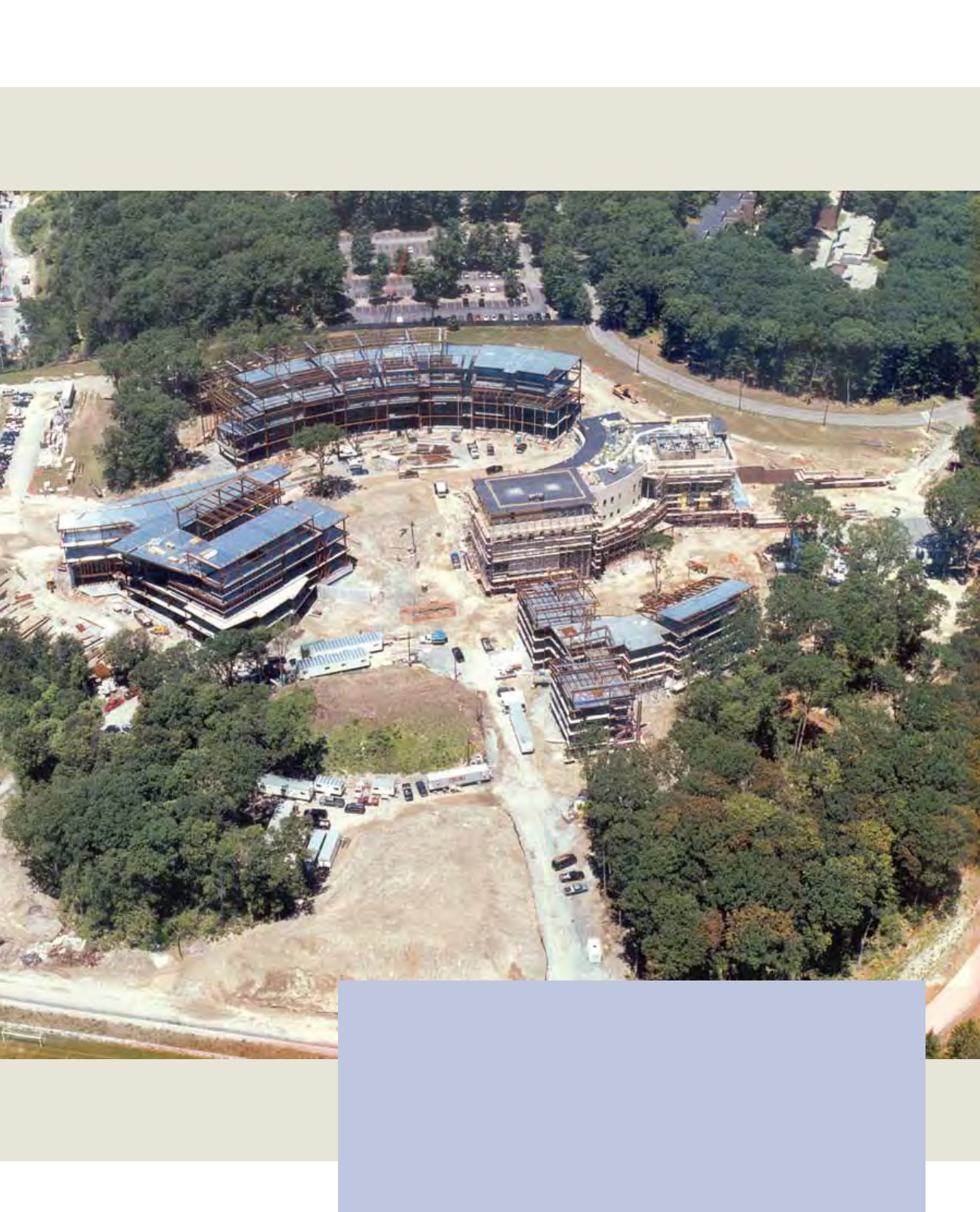
18
If you build your castles in the air,
your work need not be lost; that is
where they should be. Now put the
foundations under them.
10
— Henry David Thoreau
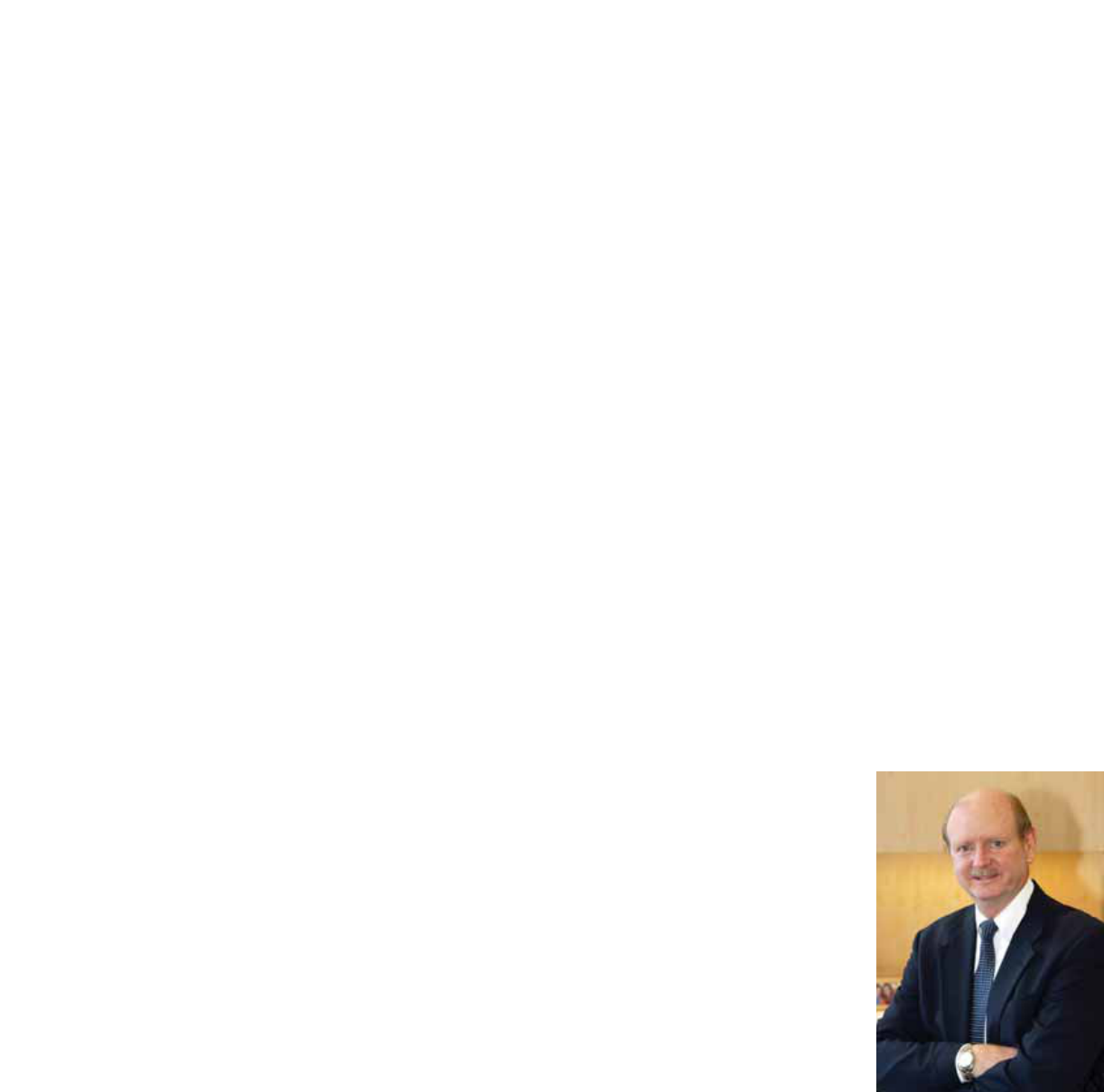
19
awrence Milas and the board were doing
their homework, compiling their wish list
and talking to as many people in engineering
education and engineering businesses as they
could. On the advice of Jon C. Strauss, president
of Harvey Mudd College, Milas contacted
Richard Miller, dean of engineering at the
University of Iowa, to discuss whether Miller
would be willing to become a candidate for
president of Olin College. Miller’s credentials
spoke to all the issues that Milas was trying to
address at Olin. He had modernized Iowa’s engi-
neering curriculum and facilities, and had created
the nation’s first Technological Entrepreneurship
Certificate Program for engineers. He had the
teaching credentials, the professional reputation
and the innovative temperament that would both
serve the Olin vision and establish its credibility
as an academic enterprise.
Milas’ overtures, however, were not immediately
welcome. Miller had just turned down another
offer to relocate, and he and his family were just
settling back into their routine. But Milas was
persistent — the two men should at least meet
to talk about it. Miller went to meet Milas at his
Florida office to hear what he had to say.
The conversation lasted for the better part of
two days, as Milas laid out his vision of the new
school. Overall, Olin’s educational goals were
consistent with the changes Miller had been
trying to make at Iowa. Two ideas, however, were
especially compelling.The first was that the Olin
Foundation would finance the costs of the proj-
ect, down to tuition stipends that would allow
students to attend virtually for free. Olin’s would
be possibly the only college presidency in the
country for which fundraising was not the highest
priority; rather than being the frontman for
raising money, the president would actually be
able to devote his energies to making the project
work. The second was the idea of continuous
innovation and improvement, a college that
would not fall into the complacency of other
successful schools but instead constantly challenge
itself to improve and take the risks necessary to
maintain innovation. That was an attitude that
Miller had not encountered before in higher
education, and one that he
regarded as a “challenge
worth dedicating your
life to.”
11
Miller went back to Iowa
and wrote out the ideas
that the conversation
inspired; he sent his notes
to Milas. He also remem-
bered that in his previous
position at USC, he had
taught and held offices in
Olin Hall and Vivian Hall
— both the result of Olin Foundation grants —
and that the foundation had a long history of
involvement in engineering education and a
strong reputation for delivering on its commit-
ments. The foundation had the money and had
developed a credible business plan. Miller’s hat
went into the ring.
The Less-Than-Once-in-a-Lifetime Opportunity
Richard K. Miller
L

20
To evaluate possible candidates, the foundation
formed a national search committee consisting
of the four directors and several distinguished
higher education leaders. Milas screened the
candidates and chose the best two or three to
be brought before the committee for interviews.
The committee selected Miller in a unanimous
vote. He took office in February 1999 as the first
employee of Olin College.
With the addition of Miller as president, the
implementation of the foundation’s conceptual
plan accelerated. Miller was tireless in his efforts
to get the college started. His commitment of
time and energy, combined with an intuitive
sense of what was the right course of action for
the college, set a chal-
lenging standard for his
staff. Miller’s leadership
by example was very
effective and inspired
and motivated his staff to
reach extraordinary levels
of accomplishment. In a
short time Miller left no
doubt in the minds of
the foundation’s directors that choosing him as
president was the right decision.
Miller not only embraced the earlier planning,
but also worked with his staff on new strategies
for areas yet to be developed, like faculty hiring,
curriculum development and student recruiting.
He and Milas worked well together, making the
invention phase more successful than might have
been possible without their close consultative
relationship.
Miller’s strong leadership on campus was, at
the least, matched by his being an extremely
effective off-campus spokesman for the college.
Although Miller had expected to focus primarily
on internal busi-
ness in leading
the college, his
ability to com-
municate the
Olin College
story off-campus
became an enor-
mous asset in
gaining almost
instant respect for
the college from important members of the engi-
neering education community and the media.
Miller joined the college not only as the first
employee, but as the first outside member of the
Board of Trustees, which until that point had
consisted of the four directors of the F. W. Olin
Foundation: Lawrence W. Milas,William J.
Schmidt,William B. Horn and William B.
Norden. Over the next few years, the college’s
board would further expand and diversify its
membership.
For the most part, colleges grow incrementally,
adding new functions and structures as the need
arises and trying to retool those that become
obsolete. So, one good part about starting from
scratch, as Olin did, was that everything — the
structures, the equipment, the people — can be
planned exactly the way you want it. The harder
part is that all those decisions have to be made at
the same time. “The College That Doesn’t Exist
— Yet!” (in the words of an early poster) had to
be planned and guided by the Administration-
That-Didn’t-Exist, the Faculty-That-Didn’t-Exist
had to plan the Curriculum-that-Didn’t-
Exist…and so on.
Developing the campus master plan was carried
out by the foundation directors under Milas’
leadership and began before, and ran parallel
Two ideas were especially
compelling: The Olin
Foundation would finance the
costs of the project, down to
tuition stipends that would
allow students to attend
virtually for free. The second
was the idea of continuous
innovation and improvement,
a college that would not fall
into the complacency of other
successful schools.
President Miller became very
adept at explaining Olin to the
media.
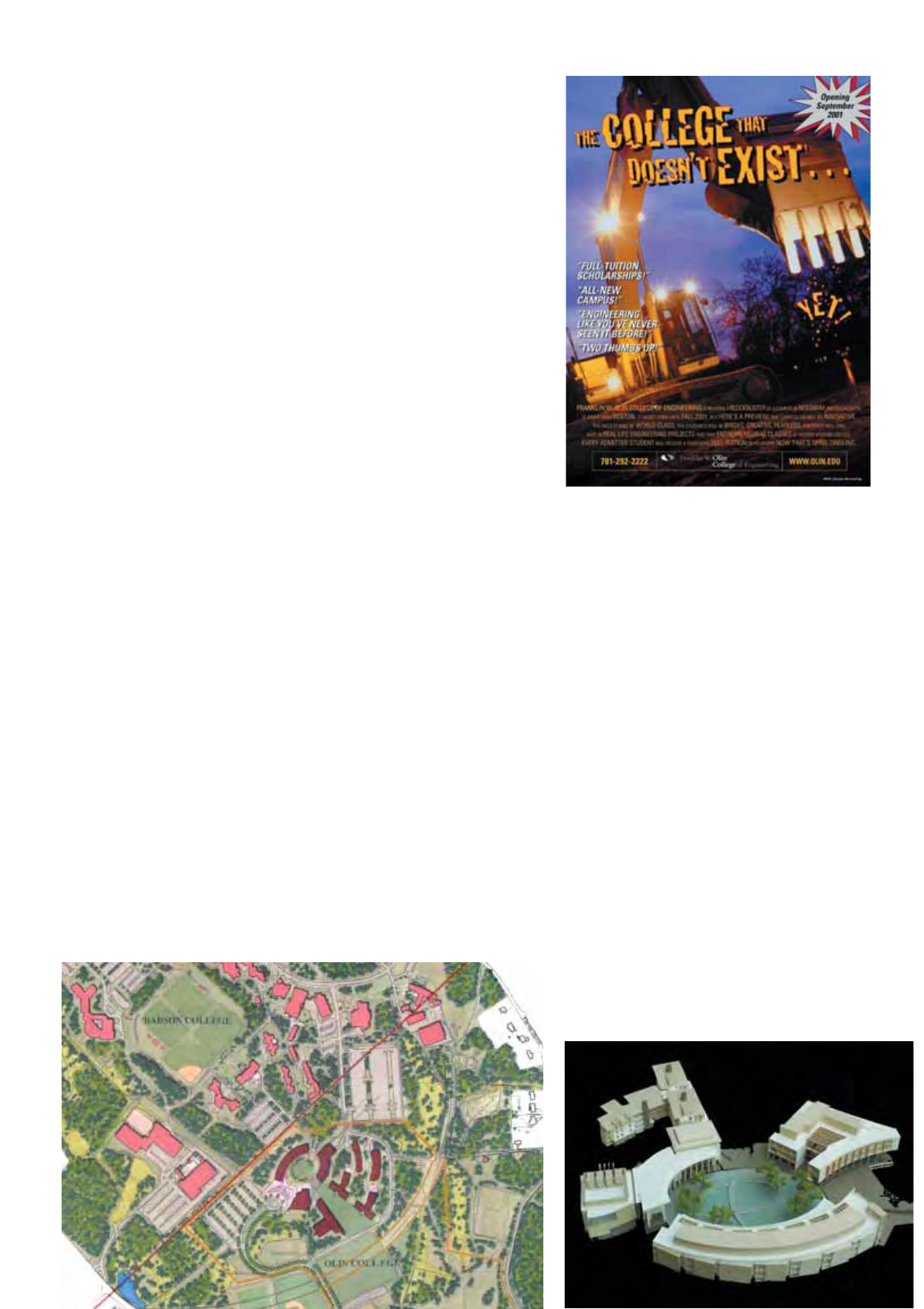
with, many of the early founding milestones,
including the receiving the charter and hiring the
first employees. For help in developing the cam-
pus plan, Milas turned to Vanasse Hangen
Brustlin, Inc., real estate acquisition specialists;
Dober, Lidsky, Craig and Associates, facilities
planning consultants; and Perry Dean Rogers
Partners, architects specializing in institutional
and academic structures. A key role in this effort
was played by James Eifert, the Rose-Hulman
educator who also had assisted in the charter
effort. Eifert’s job was to develop a detailed vision
of the academic program for use by the campus
architects in planning buildings. Based on his
own experience as an educator, Eifert’s plan
reflected the innovative approach that he and
Milas had discussed. The plan was later fine-
tuned by the Olin administration and faculty
after they were hired.
To construct the campus, the foundation decided
to purchase the land from Babson College:
70 undeveloped acres adjacent to the Babson
campus on the Needham-Wellesley town line.
It was no accident that Olin came to be located
near Babson. Top ranked in entrepreneurship,
Babson was the perfect partner for the sort of
entrepreneurially minded engineering education
Olin had in mind. Eventually, the two institutions
would come to share faculty, academic centers
and services as part of a wide-ranging collabora-
tion.
The site Olin purchased from Babson, hilly in
some places and low-lying and boggy in others,
was a tangle of trees and brush. For immediate
use, the college acquired a row of houses right
along the roadway in front of the meadow and
turned them into temporary offices.
Physically, the campus was placed as close to
Babson as possible, with walkways and open
spaces linking the two sites in order to facilitate
connections between the schools. The architects
of Perry Dean Rogers Partners laid out a central
oval — a modern twist on the traditional quad-
rangle — ringed by the campus’ main academic
buildings: the Olin Center, the Campus Center
and the Academic Center. The oval crowns the
topographic high point of the site, and wide
21
This fall 2000 poster was mailed to
high school guidance counselors
nationwide to create awareness.
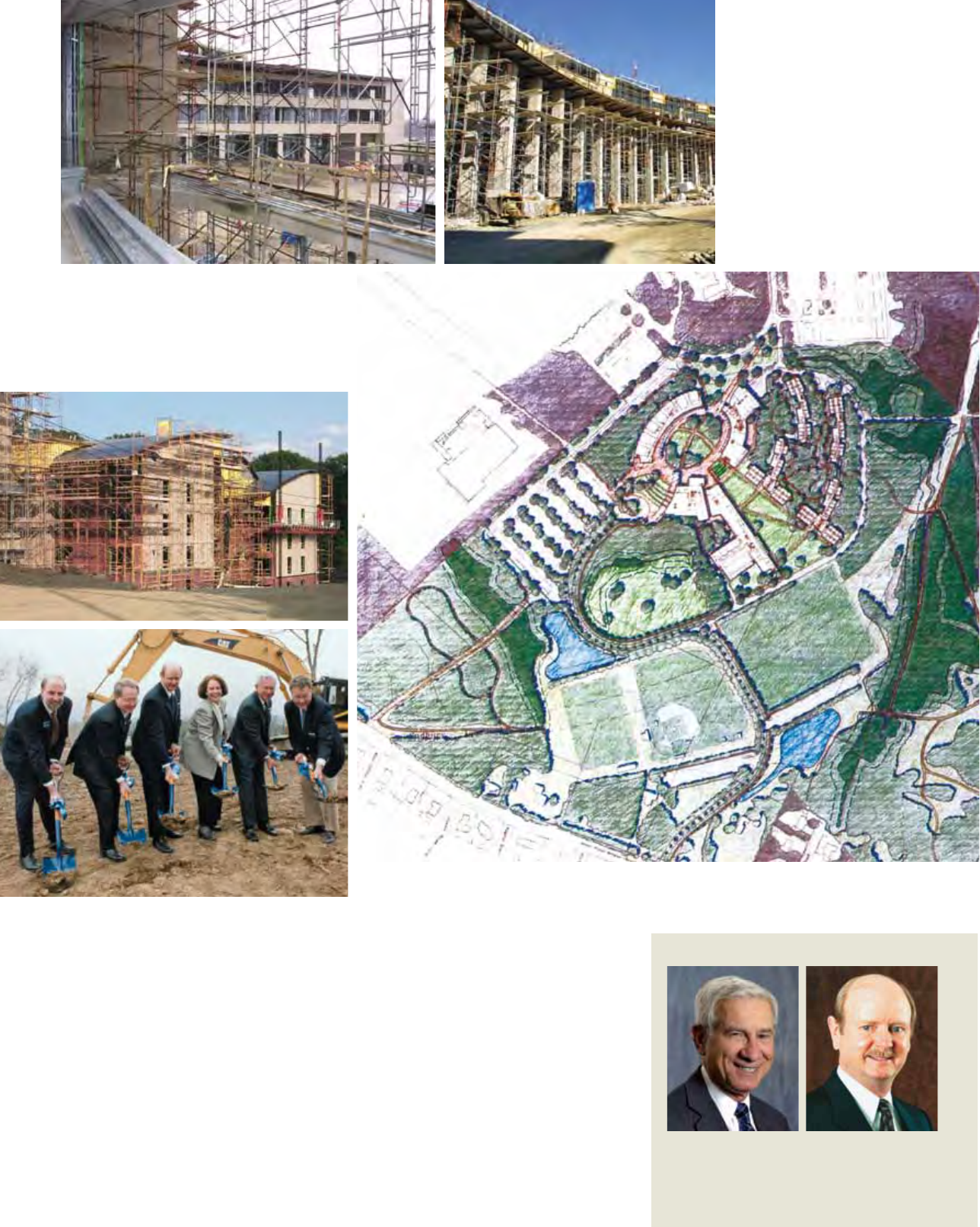
22
The first phase of Olin campus
construction took place from early
2000 through 2005.
breaks between the encircling structures are filled
with long vistas over the Great Lawn and the
wooded slopes. Glass facades on the interior-facing
walls of the encircling buildings reinforce the role
of the oval as the focal point of the campus.
Inside, the most notable feature was the fluid
arrangement of the faculty offices and labs; rather
than clustering academic specialties together, the
various facilities are interwoven to foster interdis-
ciplinary collaboration and sharing of ideas.
Student dorms were
designed to promote
community as well as
privacy. Although
students enjoy double-
occupancy rooms as well
as suites with private
bedrooms and bathrooms,
inviting communal spaces
furnished with such
amenities as fireplaces,
Olin Foundation President Lawrence Milas
oversaw the early development of the
college and chaired the committee that
hired Richard K. Miller as president.
Original Leadership Team
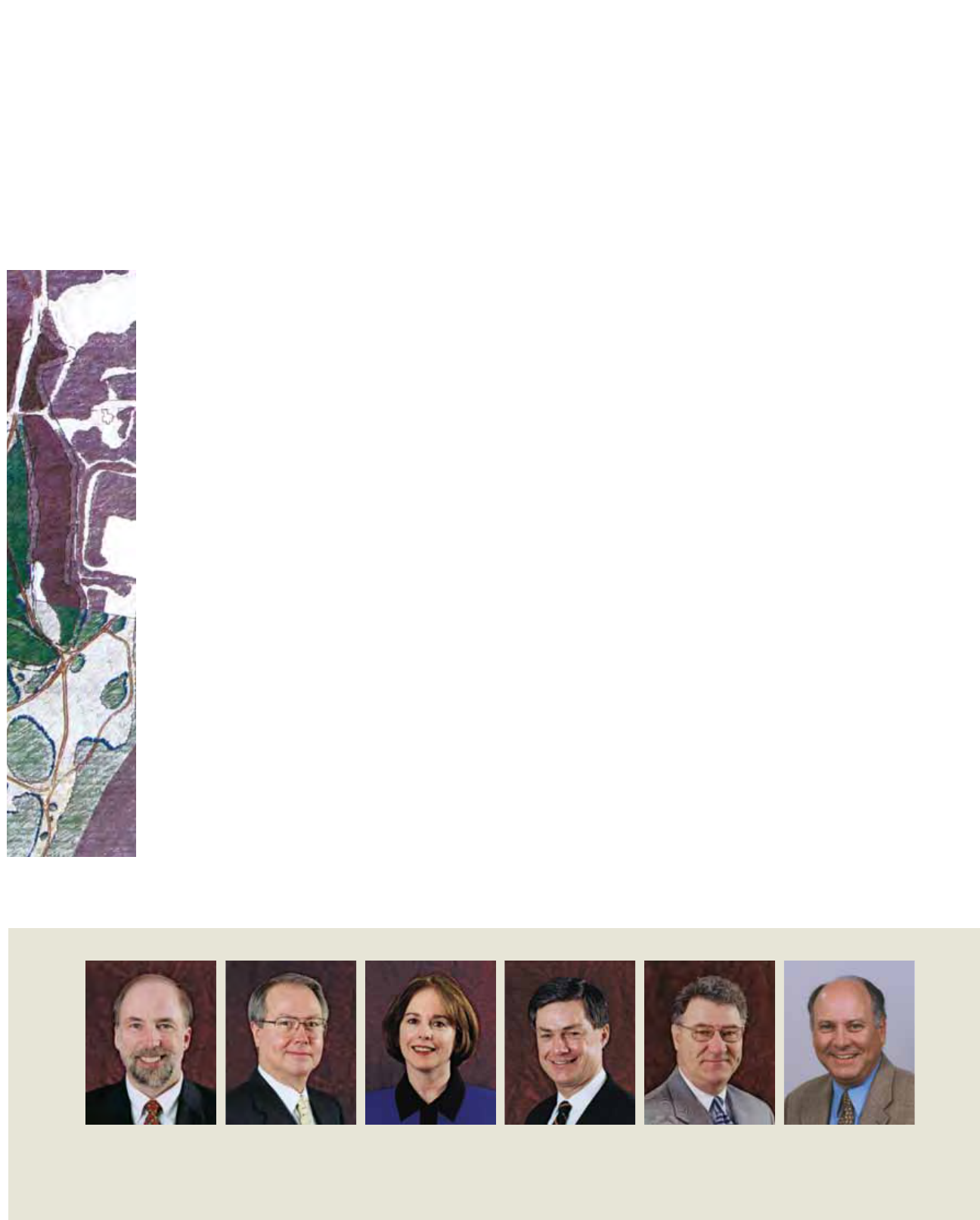
common lounges and very comfortable furniture
provide tempting venues for collaborative work
or socializing. The campus facilities have been
recognized by Princeton Review as among the best
in the nation.
While the campus was being built, Milas and
Miller were assembling their core leadership
team. Stephen Hannabury was hired to be vice
president for administration and finance from
Boston University’s School of Management,
where he had overseen a major construction
effort and maintained strict budgetary control
for 14 years. David Kerns, a widely respected
academic, came over from Vanderbilt to assume
the office of provost.Also from Vanderbilt,
Sherra Kerns was hired as the vice president
for innovation and research, a unique position
that established these priorities at the very top
of the Olin structure. Charles Nolan, legendary
in admissions circles for his management ability,
had only to cross the street from Babson to
become Olin’s first dean of admission, but
Duncan Murdoch, known as one of the most
creative marketers in higher education, had to
cross the country from USC to take the post of
vice president for external relations and enroll-
ment. Roger “Rod” Crafts, a veteran student
life professional, joined Olin from Brandeis
University in August 2000, completing the
Leadership Team in its original configuration.
Like Miller, all were known in their fields for an
innovative, even adventurous, approach to their
work. All were drawn to Olin by the uniqueness
of its vision, and by the “less-than-once-in-a-life-
time” opportunity to use their knowledge and
skills to create something new and effective.
Their formidable professional reputations put the
academic world on notice that Olin College was
a serious enterprise.
Bringing in an equally respected faculty was the
next task, one that fell primarily to Richard
Miller, David Kerns and Sherra Kerns. The ideal
Olin professor would be a gifted teacher, deeply
committed to the classroom and accomplished
in the lab. He or she would be creative, open to
collaboration and willing to teach in new ways.
Above all, faculty members were expected to be
inspirational teachers of undergraduates. The
ideal faculty member would also be committed
to intellectual vitality through scholarly and other
creative endeavors, and would bring this vitality
into the classroom. All faculty members would
be expected to pursue nationally visible achieve-
ments. Moreover, he or she would have a broad
range of interests that extended beyond science
and engineering to history and society, arts and
letters. The wish list was long and comprehen-
sive.
23
Stephen Hannabury David Kerns Sherra Kerns Charles Nolan Duncan Murdoch Roger “Rod” Crafts
VP for Administration Provost VP for Innovation Dean of Admission VP for External Dean of Student Life
and Finance and Research Relations and
Enrollment
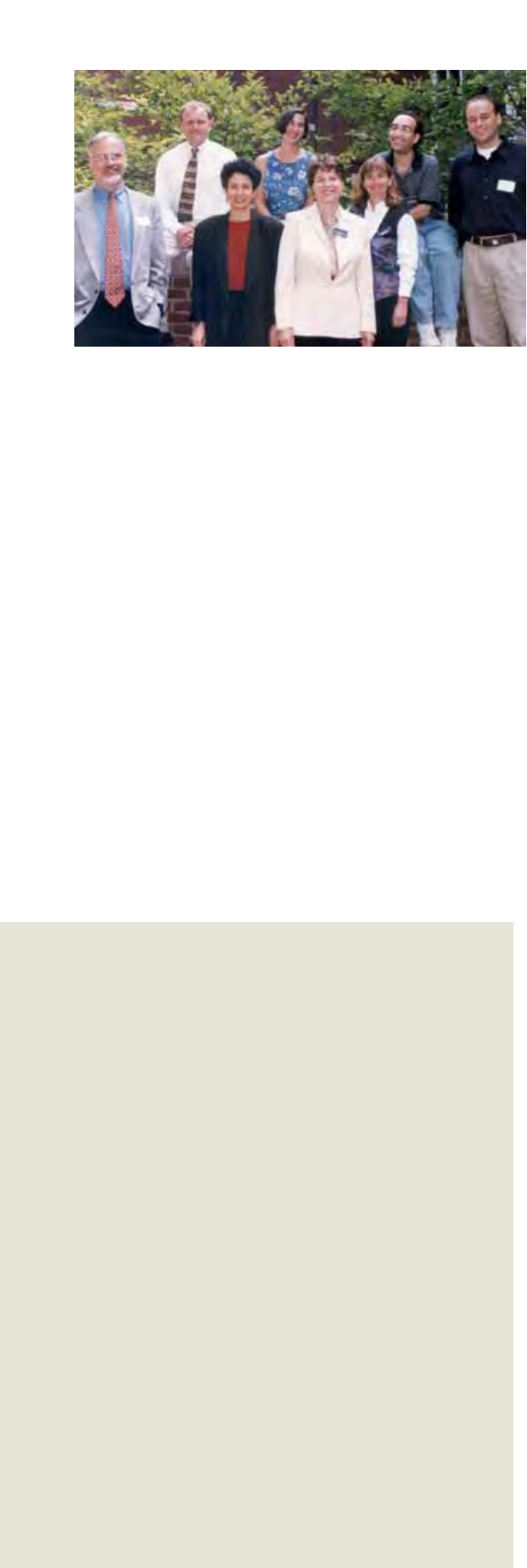
While Olin’s new approach posed an exciting
challenge for educators, there were also serious
drawbacks. Most of the potential faculty had not
yet heard of Olin. Also, the college was much
more of a concept than a reality at this point,
and Olin would not offer tenure, nor would it
provide an opportunity to work with Ph.D.
students. Nevertheless, job ads were placed in
the professional journals, and Miller, Kerns and
Kerns went on the road, speaking at professional
conferences and meetings about Olin and its
innovative approach to education.
Clearly, they were persuasive — they received
approximately 1,500 applications for the initial
eight slots that they were trying to fill. Many of
the applicants had academic or professional quali-
fications in the arts and humanities, as well as in
science or engineering, and were searching for an
opportunity that would allow them to integrate
their many interests. Several were attracted, again,
by the rare opportunity to be involved at the
start and to create something new and meaning-
ful.
Olin’s founding faculty arrived in the fall of
2000.
With the selection of the initial administration
and faculty, the implementation process was in
full swing. The blueprint for this process was a
document entitled “Invention 2000,” a two-year
strategic plan that encompassed curriculum
development, student life, administration, market-
ing, finance and governance.
The “discovery” phase of curriculum develop-
ment consumed the new faculty’s first year at
Olin. Faculty teams studied curricula and teach-
ing models at various institutions and visited, or
hosted visits from, more than 50 colleges, busi-
nesses and government agencies. A number of
these outside advisers were also appointed to a
President’s Council to provide ongoing advice.
About midway through the first year, the broader
ideas gathered through consultation coalesced
into the “Bold Goals,” a vision statement of
Olin’s educational ideals, against which all cur-
riculum decisions would be tested. The Bold
Goals for Olin’s curriculum were as follows:
• Hands-on design projects included in the
education plan for every year
• An ambitious and authentic senior capstone
project representative of professional
practice
• Opportunities to work independently, as
team members and as team leaders
• Opportunities to perform before audiences
comprising experts in the field of the presen-
tation or performance
Founding faculty, hired from an initial pool of more than 1,500 applicants:
(from left) Dr. John Bourne, Dr. Daniel Frey, Dr. Diana Dabby, Dr. Lynn Andrea
Stein, Dr. Hillary Berbeco, Dr. Joanne Pratt, Dr. James Propp and Dr. Brian
Storey. Propp left before the Partner Year. Not shown: Dr. Stephen Holt.
Provost David Kerns and VP Sherra Kerns were personal
friends with Paul Penfield, then head of the Electrical
Engineering and Computer Science Department at MIT. In
1999, as they were considering the invitation of President
Miller to join the Olin team, Sherra said to Paul, “It seems
like a once-in-a-lifetime opportunity,” to which Paul
quickly responded, “Oh no, statistically, having the oppor-
tunity to start a college is a much-less-than-once-in-a-
lifetime opportunity.” This statement was a key factor in
the Kerns’ decision to leave Vanderbilt for Olin.
Several years later, when Provost Kerns was recruiting
Dr. Michael Moody to be dean of the faculty, Moody said,
“Well, this must be a once-in-a-lifetime opportunity for
you,” and David Kerns reiterated the statement, “Oh no, it’s
a much-less-than-a-once-in-a-lifetime opportunity.” Dean
Moody later recounted that this was a pivotal factor in his
decision also.
The Less-Than-Once-in-a-Lifetime
Opportunity
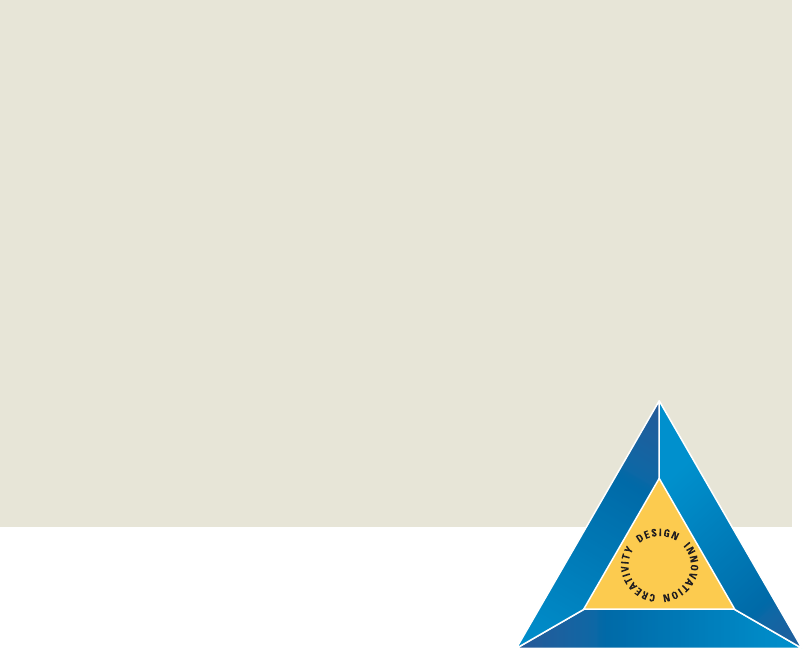
25
• An international or inter-
cultural immersion
experience
• A substantial constructive contribution to
society through social responsibility and
philanthropy
• Ability to communicate logically and persua-
sively in written, spoken and visual/graphic
forms
• Self-sufficiency and the ability to articulate
and activate a vision and bring it to fruition
These Bold Goals were bounded by a conceptual
framework that came to be known as the
“Olin Triangle.”At the peak of the Triangle was
Superb Engineering, supported by the Arts,
Humanities and Social Sciences (“AHS”)
(encompassing Design, Creativity and Innovation)
and by Entrepreneurship (including Philanthropy
and Ethics). In order to prevent students’ creative
endeavors from being swept aside by the pressure
of coursework, the first two years of the curricu-
lum incorporated work in the arts and humani-
ties, culminating in an AHS capstone project. In
addition, students were allowed to accumulate
some of their nondegree credits through their
“Passionate Pursuits,” their chosen areas of
artistic/creative interest. The college would offer
scheduled time and faculty and financial support
for the Passionate Pursuits and for the various
organizations that provide services to
the community and the college. Olin’s
educational mission was defined as
preparing well-rounded students able
to use their technological expertise to
shape the future and solve society’s
problems, whether or not they ulti-
mately went on to be engineers.
Beyond the Bold Goals and the dis-
covery of best practices, it was neces-
sary to configure an actual four-year
curriculum, one that would fulfill the
desired educational goals, meet ABET’s
accreditation expectations, and fall within the
practical constraints of time and cost. This task
was entrusted to a subcommittee called the
Curricular Decision-Making Board (CDMB).
The CDMB winnowed out the many options to
come up with a curriculum plan that emphasized
both course work and project experience. In the
following year, curriculum ideas were tested on
the Olin Partners, 30 students who were recruit-
ed to spend a special pre-enrollment year assisting
in the development of the college’s programs.
Partners took part in the ongoing CDMB, and
then tested curriculum ideas as four-week “mod-
ules.” Successes and failures were evaluated, and
the changes were built into the growing
curriculum plan. The final product was based
on a two-year foundation of course and project
work, a third year of specialization in which the
student focuses on a particular area of interest
and a fourth year (realization) during which the
expertise is applied to a project of professional
caliber.
Differing from the traditional engineering cur-
riculum, projects form a significant percentage of
the student’s learning plan from the start (a strat-
egy known at Olin as “do-learn” — that is,
learning by doing); the percentage of project
In February 2001, Provost David Kerns
arranged a retreat at the Warren
Conference Center in Ashland, Mass., for
the founding faculty to consider the Olin
curriculum and other academic matters.
After dinner on the first day, without any
agreed-upon schedule or plan, faculty
members began assembling in the
downstairs meeting room, where they
had discussed wide-ranging issues all
day; eventually, everyone was there.
Picking up a marker and standing before
Bold Steps: How the “Bold Goals” Came into Being
a white board, VP Sherra Kerns said, “OK,
without defining the curriculum in detail
at this point, let’s list the things we have
come to agree upon.” By the end of the
evening, the group had articulated the
“Bold Goals,” which would feature
prominently in virtually every discussion
about Olin’s curriculum for the next
several years.
SUPERB ENGINEERING
ENTREPRENEURSHIP
ARTS, HUMANITIES
and SOCIAL SCIENCES
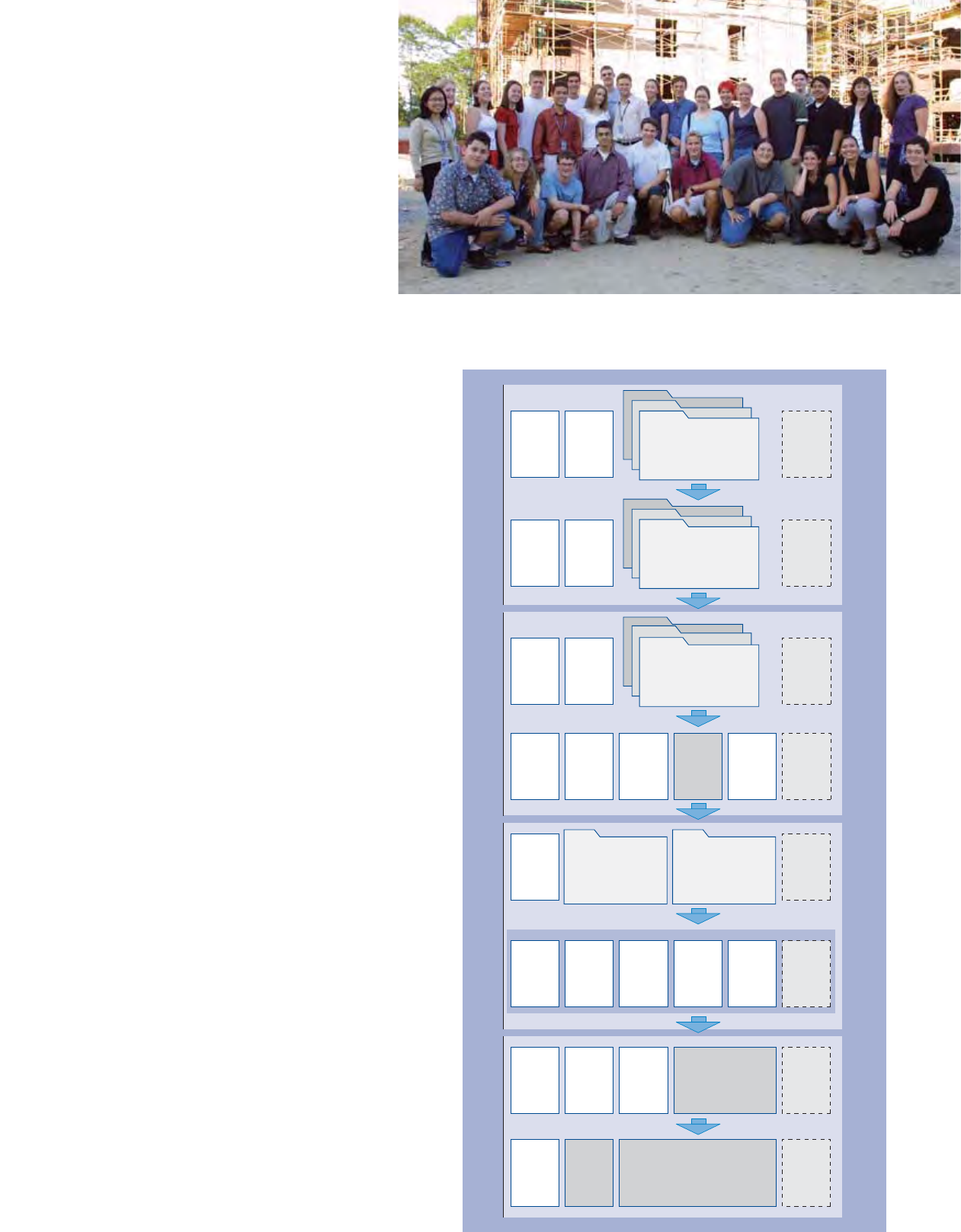
work increases in importance over the
four years. In the first two years, projects
are structured around integrated course
blocks (ICBs), large course blocks that
combine two areas of study (say, engi-
neering and biology) and an interdisci-
plinary project. The ICB model empha-
sizes the interdisciplinary nature of Olin’s
teaching and provides teamwork opportunities
for both faculty and students. Another distinctive
feature of the curriculum is the design stream,
which provides coursework in engineering
design continuously throughout the curriculum.
The fourth-year senior capstone project (later
known as SCOPE), pairs student teams with
businesses to develop a solution that incorporates
the students’ specialized skills and meets the
business clients’ requirements and schedules. Thus
at the end of four years, students not only learn
the fundamentals of engineering science, but also
can apply these techniques to the solution of
real-world problems. Another unusual curricular
element, Olin Self-Study, provides opportunities
for independent research and lifelong learning.
While the individual elements of the curriculum
continued to morph over the first few years,
undergoing tweaks and name changes, its basic
structure has remained remarkably close to the
original vision.
26
The Olin Partners arrived in Needham in August 2001 and lived in a temporary
modular residence hall while the campus was being built.
One of the earliest published
versions of the Olin curriculum.
Arts,
Humanities
and
Social
Sciences
4
Arts,
Humanities
and
Social
Sciences
5
Technical
Elective
1
Technical
Elective
2
Free
Elective
3
Free
Elective
4
Arts,
Humanities
and
Social
Sciences
6
Technical
Elective
3
Advanced
Math
Senior
Capstone
Arts,
Humanities
and
Social
Sciences
7
Arts,
Humanities
and
Social
Sciences
Capstone
Passionate
Pursuits
(optional)
Passionate
Pursuits
(optional)
Passionate
Pursuits
(optional)
Passionate
Pursuits
(optional)
YEAR 3YEAR 4
Integrated Course Block:
Engineering Core 1
• Class
• Project
Integrated Course Block:
Engineering Core 2
• Class
• Project
Senior
Capstone
POSSIBLY AWAY
Arts,
Humanities
and
Social
Sciences
1
Introduction
to
Modeling
and
Control
Arts,
Humanities
and
Social
Sciences
2
Free
Elective
1
Arts,
Humanities
and
Social
Sciences
3
Signals
and
Systems
Applied
Mathematical
Methods
Free
Elective
2
Software
or
Systems
or
Thermo
Sophmore
Design
Project
Biology Passionate
Pursuits
(optional)
Passionate
Pursuits
(optional)
Passionate
Pursuits
(optional)
Passionate
Pursuits
(optional)
YEAR 1YEAR 2
Option 3
Option 2
Option 1
Integrated Course Block:
• Mathematics (calculus, diff. eq’s.)
• Physics (mechanics, thermo)
• Design Project
Option 3
Option 2
Option 1
Integrated Course Block:
• Mathematics (vector calculus,
linear algebra)
• Physics (E&M, circuits)
• Design Project
Option 3
Option 2
Option 1
Integrated Course Block:
• Materials Science
• Business Basics
• Design Project

27
he Olin Web site does not sell little pink and
blue bibs that say “Olin Class of ??” It may
come to that someday, but we’re not there today.
Yet the “bib gap” represented a serious challenge
for the Olin admission staff. Given the stiff com-
petition for top-tier students and the undeniable
attraction of a prestigious college name, how
could Olin, with its still-unproven newness, get
itself noticed?
From the outset, the admission staff crafted a
two-pronged strategy designed to appeal to both
the exuberance of 18-year-olds and the caution
of
their parents. For the prospective students, Olin
mailings were all attitude and jarring colors.They
featured bungee jumpers (“Fearless?”) and huge
growling excavators. They played off the exclu-
sivity of established schools by posturing with a
mock exclusivity of their own: “There’s only one
thing cooler than getting into Harvard, MIT and
Stanford — TURNING THEM DOWN!” One
of the first admission pieces, “7 Reasons You
Should Apply to an Engineering College That
Doesn’t Exist,” was a card fan anchored at the
corner by an aluminum rivet and mailed in a sil-
ver Mylar envelope. The prospectus was bound
with silver duct tape. These brochures were
meant to attract notice, not be tossed out with
the junk mail.
The appeal to parents was more direct and hard-
headed — tuition will be free; the professors have
world-class credentials and do the actual teach-
ing; the major innovative technology companies
(read: your child’s future employers) agree that
this is the future of engineering education.This
was the anti-legacy appeal — because Olin is not
an ancient ivy-covered college, your child will be
given opportunities to excel and develop that no
one else could offer.
Students who did apply to Olin began the
process with the familiar rituals of seniors every-
where — the SATs, the APs, the two application
essays. But those who made the first cut were
invited to another Olin innovation, the
Candidates’Weekend. The candidates were
Building the Plane As It’s Flying
The “7 Reasons” brochure, one of
Olin’s earliest publications, was used
to recruit students to the college.
“Harvard has a fifteen-year window in which to attract
a student applicant, while Olin has to get their attention
in just ten months.”
– Duncan Murdoch, Olin’s founding external relations and enrollment VP
T

28
assigned to small
groups and given
projects to com-
plete together
(say, Styrofoam
towers or
bridges). They
were interviewed
and observed
by faculty and staff, and in light of Olin’s strong
emphasis on collaborative learning, the final
offers of admission were based upon teamwork,
leadership and self-expression. For students and
their parents, Candidates’Weekend made the
transition less daunting by providing an opportu-
nity to meet impressive potential classmates and
teachers, and an assurance that the school really
did exist after all. For the Admission Office,
Candidates’Weekend was that last sales pitch,
proof that the school could attract brilliant
students. Olin students almost invariably cite
Candidates’Weekend as the tipping point that
led them to
choose Olin.
Olin’s most innova-
tive and productive
admission draw,
Partner Year, was
not even part of
the original plan.
The college was scheduled to open for students
in fall 2001. The initial group of faculty had been
hired and campus construction was under way.
The application groundwork had been laid the
year before by sending high school juniors a
bright blue brochure with the image of a fine
Georgian campus crossed by a slashed red circle:
“You Can’t Get Into Our College in 2000,
because we don’t exist — yet.” The pamphlet
urged them instead to “pass it on to the tenth-
grader who ruins the curve in your AP Physics
class, or the kid next door whose eighth-grade
project is ‘patent pending.’”
Thirty-thousand new recruitment brochures had
just been printed and delivered when it became
all too clear that the college was not going to
open on time. Construction of the facilities had
been delayed and the academic program was not
ready. Canceling the freshman class would halt
the momentum that the college had worked hard
to build and severely damage its budding credi-
bility. In a crisis planning retreat, the administra-
tion collectively settled on an innovative idea to
admit a smaller class of “Olin Partners,” a select
group whose first year would be spent helping
to create the college — collaborating with the
faculty on curriculum development and helping
to develop the student culture. Thirty-thousand
Post-it notes were hand-pasted into the
brochures to announce the program. New
The first Candidates’ Weekends, held in March 2001, helped recruit 30 Olin
Partners and 14 virtual Partners. The event has been held every year since then.
In 2000, the administra-
tion collectively settled
on an innovative idea to
admit a smaller class of
“Olin Partners,” a select
group whose first year
would be spent helping
to create the college —
collaborating with the
faculty on curriculum
development and helping
to develop the student
culture.
November 2001 recruitment tabloid,
geared toward high school students.
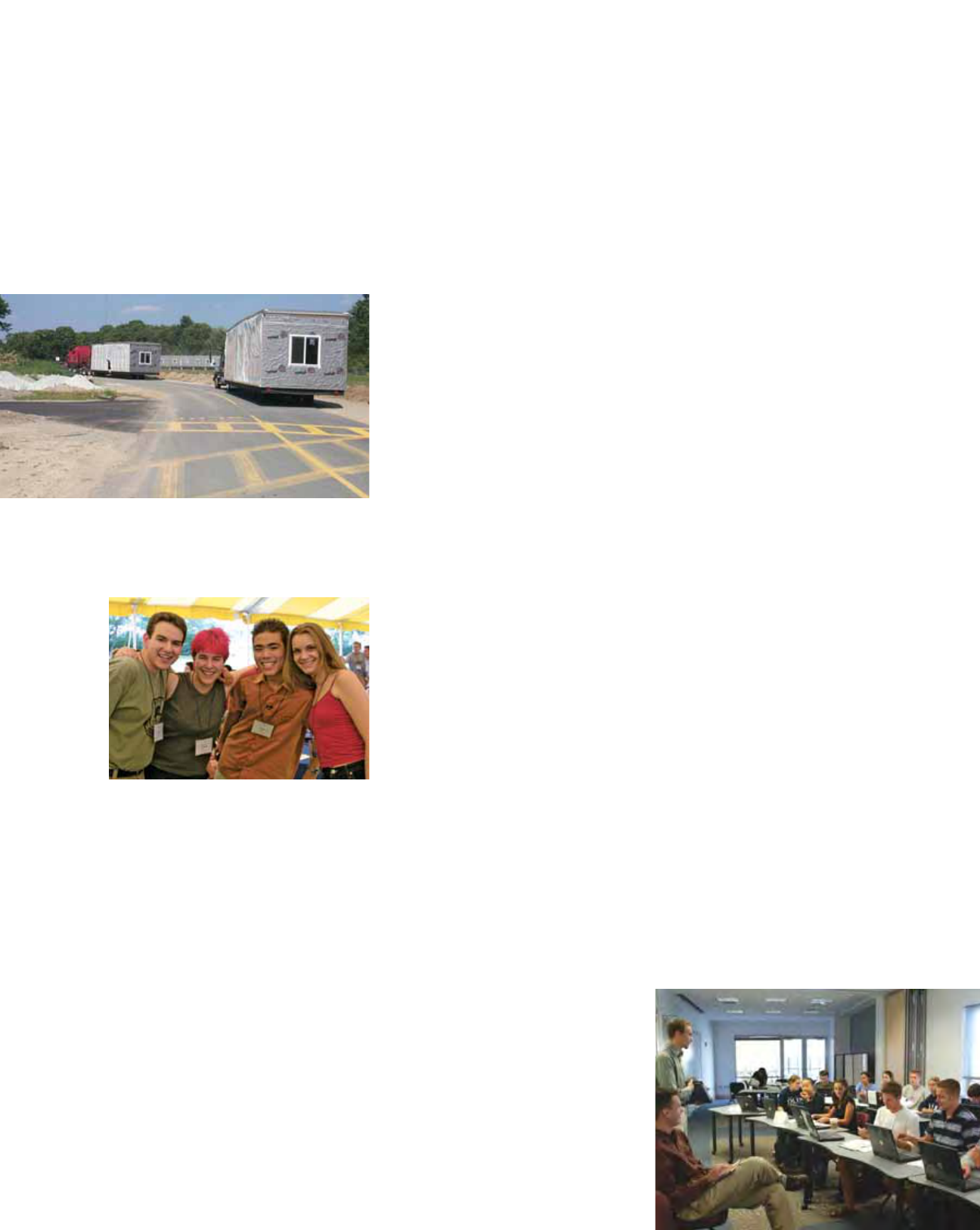
29
brochures were printed, selling the educational
and professional value of the Partner concept —
“Put THAT on a resume!” and “When Friends
Ask,‘Where Are You Going to College?’…Tell
’Em You’re Building
Your Own!”
Marketing the
Partner concept was
very successful, and
nearly 700 students
applied for the
30 places. The
temporary residence
hall planned for
student accommo-
dations would only
house 30, so 30 stu-
dents were offered
admission. Because
of the high quality
of the applicant
pool, 36 were
offered the waitlist
with a chance to
defer a year if no
openings occurred.
Surprisingly, 26 of
the 30 students
admitted enrolled. Four additional students were
admitted from the waitlist for the Partner Year.
Fourteen other students on the waitlist accepted
the deferred year, and came to be known as
“Virtual Partners.”
The Partners became, quite literally, the poster
children for Olin’s experiment — bright, articu-
late and willing to snub some of the best schools
in the country. The quality of the Partners was
stunning, by all standard measures. All of them
could point to significant accomplishments out-
side of the classroom. Some had already started
their own companies. Better still, they proved
that high quality and diversity went hand in hand
— they came from 17 different states, 25 percent
were students of color and exactly half were
women.
The Partners were both co-planners and guinea
pigs for all aspects of the Olin startup. This
process was not always smooth. Often it was not
even clear, and setting the terms of the discus-
sion, from target objectives to meeting protocol,
became the first task.
Say the words “Town Meeting” to a group of
Olin Partners and be prepared for a barrage of
sighs, laughter and a good bit of eye-rolling. The
Town Meeting was the brainstorming session,
with everyone together in the room and giant
Post-it notes stuck to the walls to record ideas
and decisions. Town Meetings could be lengthy
— some lasted for days. Nevertheless, the messi-
ness was part of the process — keep ideas in play,
question assumptions, hear from everyone, make
as many connections as possible. A deliberate
effort was made at the beginning to not “final-
ize” too many decisions too soon, but keep the
options flexible as the plan began to take shape.
Ideas were tested as “modules,” four- or five-
week sessions, each concentrating on a particular
topic such as curriculum or teaching.
The pending arrival of the first regular freshman
class in August
2002 acceler-
ated this
process, but
did not finish
it. Partners
Temporary modular housing arrives for the
30 Olin Partners. It was surprisingly nice
inside.
Four of the Olin Partners, on opening day
(August 23, 2001): (from left) Adam
Horton, Kate Blazek, Leighton Ige and
Jessica Anderson.
Olin’s first classes were held in
the Campus Center because the
Academic Center was not finished.
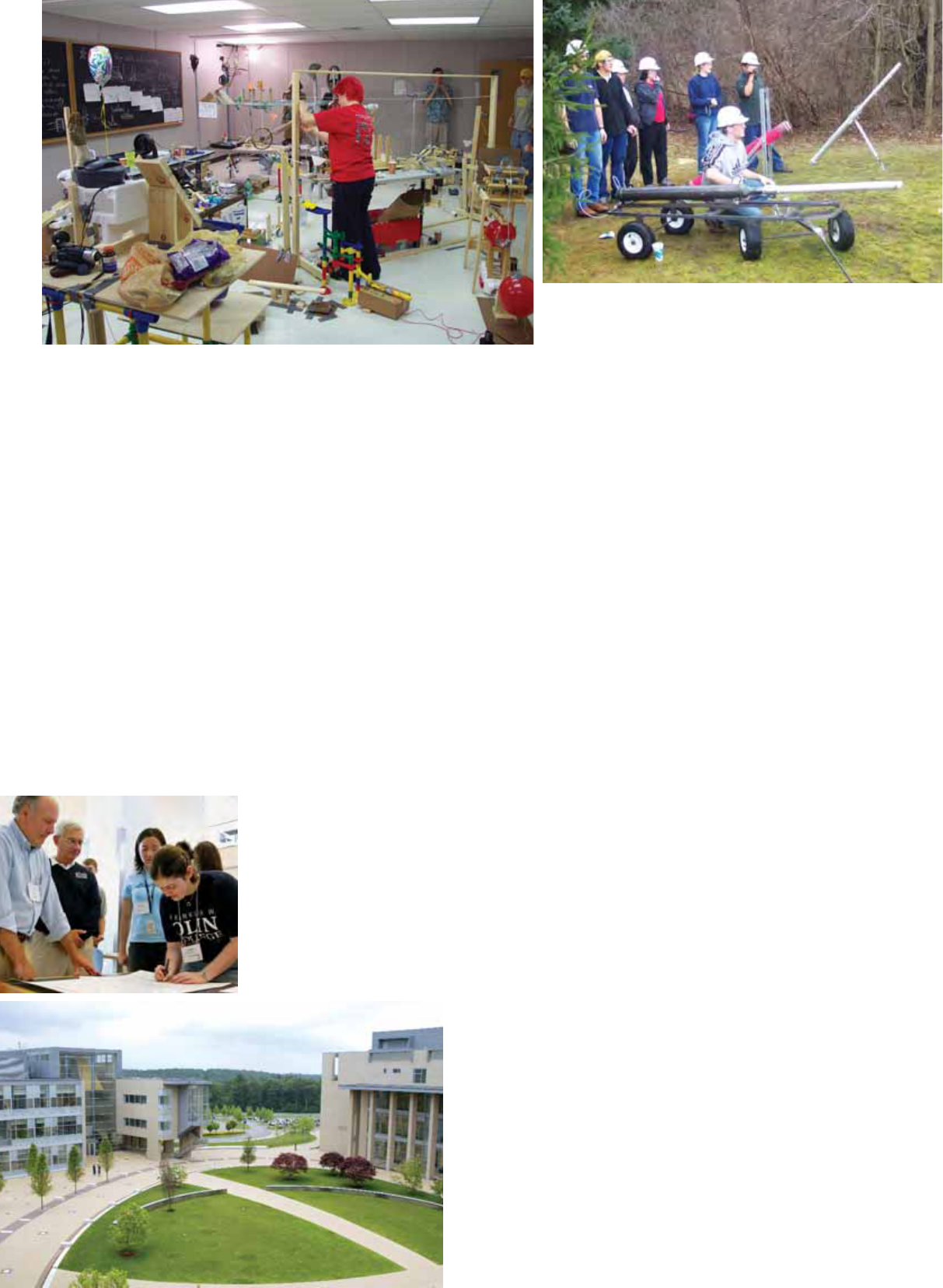
made up just under half of this class, along with
14 Virtual Partners and 32 newly admitted
students. Between classes, homework and other
activities, the discussions went on. Some wel-
comed the transition back to being students;
others found it more difficult to spend part of
their day as a student and the other part as a
colleague, and were prone to at first spend more
time on “Olin business” than on schoolwork.
For the first freshman class, each year was a new
creation, often likened to building an airplane
while flying it. Subsequent
classes came into a more
settled structure; for them,
innovation is increasingly
a process of feedback and
improvement rather than
invention. Their attraction
to Olin was the strong
appeal of the do-learn
model, the chance to inte-
grate their artistic pursuits
with their engineering, and
the opportunity to be part of a group they met
at Candidates’Weekend. They were not expected
to “create” Olin, but they were expected to keep
re-creating it.
As each new class arrived, it experienced its own
challenge: how to help Olin live up to its ideal
of continual improvement. The classes that joined
Olin after the pioneering Class of 2006 have
proven themselves equal to the task, taking up
positions of responsibility in student government,
joining committees and becoming full partici-
pants in each new milestone. In the Olin
tradition, they have become partners in the
completion and fine-tuning of the four-year
curriculum, the Inauguration and Campus
Dedication of 2003, the launching of the Olin
Expo program in 2004 and the debut of the
SCOPE program in 2005. Each class demon-
strates anew that what distinguishes Olin students
is not the year they enter, but their inventive,
pioneering spirit.
Two Partner Year projects: the 95-Step Rube Goldberg
device (left), designed to turn off an alarm clock; and the
golf ball cannon.
The Olin Partners spent many
months conceiving, writing and
debating the content of the
Honor Code. All students sign it
during their first year.
Olin’s high-tech campus
echoes, but updates
traditional academic
architecture.
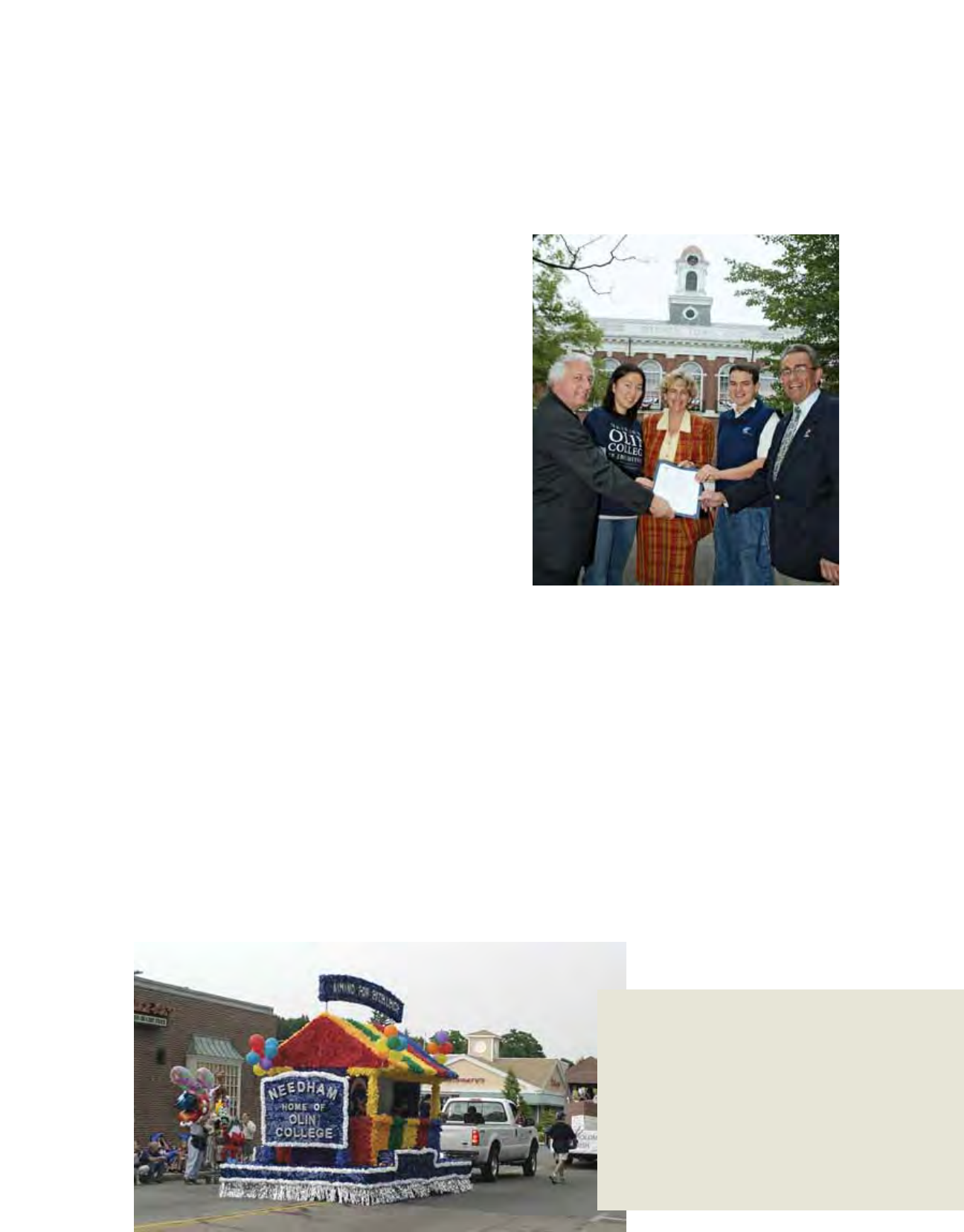
lin College is located on land purchased
from Babson College, just on the Needham
side of the Needham-Wellesley town line. A
relationship with Babson College was part of the
Olin plan from the outset, and was codified in
the Founding Precepts. Babson’s well-known
excellence in entrepreneurial training would be
a part of the Olin educational program. Olin
Foundation President Lawrence Milas had
graduated from Babson himself and was quite
familiar with the surrounding area, whose tech-
nology-business focus gave it strong potential for
recruiting faculty, business partners and students.
Moreover,William Glavin, then president of
Babson, was a strong supporter of the Olin proj-
ect and an important source of advice as the
plans progressed.
Milas was sensitive to the impact that Olin could
have on a town like Needham. He took care that
town officials and residents whose properties
abutted the proposed college site were notified of
the proposal by the foundation before the plans
were made public.Throughout the summer and
fall of 1997, he also made himself available for
meetings before the Board of Selectmen, the
Planning Board,Town Meeting and the West
Needham Civic Association (WNCA), which
represented the neighboring residents. Milas was
understandably eager for the town to support the
plans for Olin College and regard its presence as
an asset. He promised to keep the community
apprised of the foundation’s plans as they pro-
gressed and to address the concerns of the
neighbors.
12
Needham town officials were concerned about
the formal issues that typically
characterize a large-scale infra-
Needham: America’s Newest College Town
The Town of Needham proclaimed “Olin
College Week” in September 2003 to celebrate
its status as America’s newest college town.
Olin staff and students have
made a deliberate effort to take
part in Needham’s community
life, joining local service clubs,
town activities and volunteer
efforts.
O
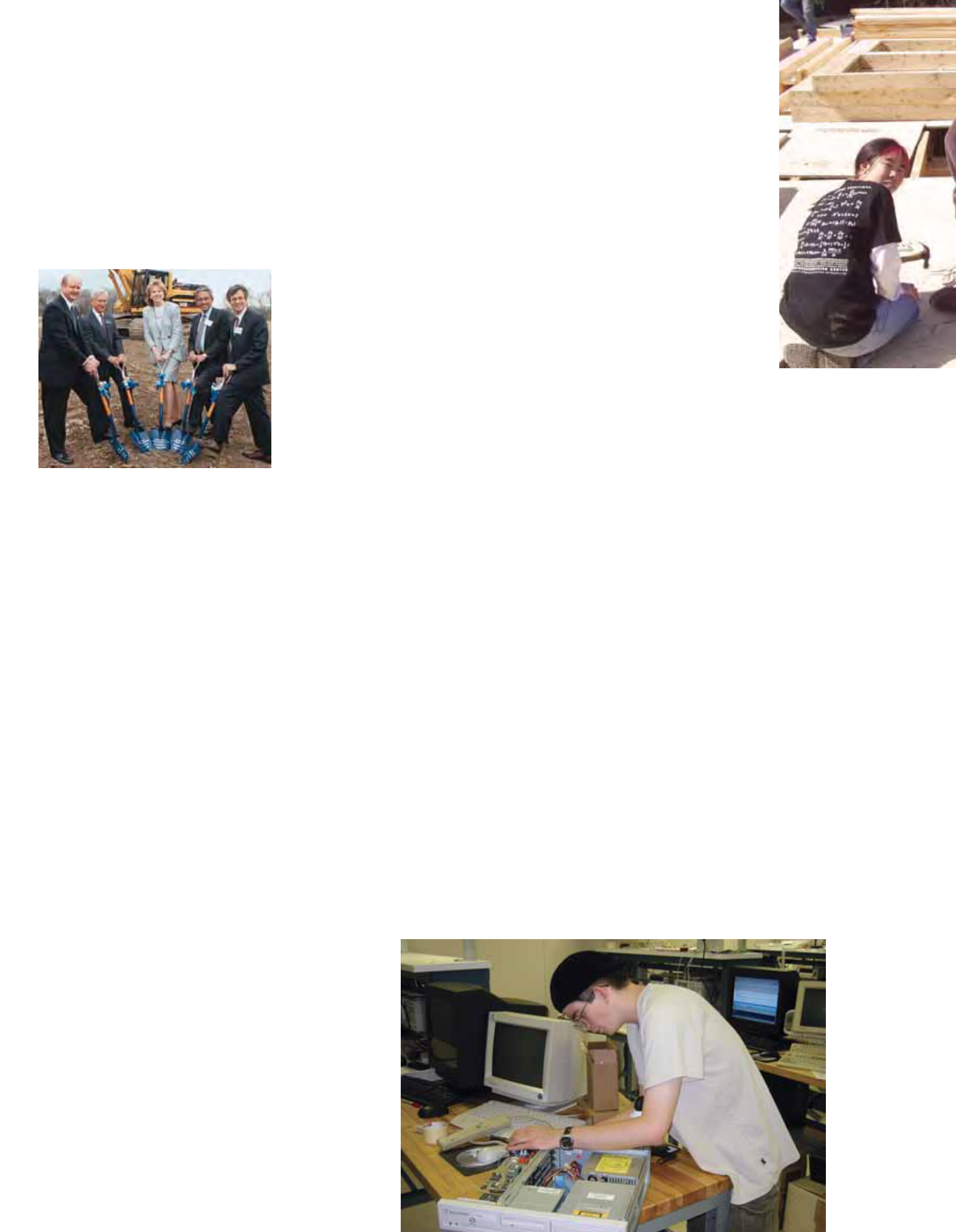
32
structure change — how to minimize the traffic
impact on busy Great Plain Avenue, and whether
the existing water and sewer system had sufficient
capacity to accom-
modate the new
campus. For the
WNCA, however,
the issues cut a little
closer to home —
their homes, to be
precise. Babson’s
vacant meadow had
acted for years as a
buffer to help control
water runoff in the
adjacent residential
properties. Parts of the site were wetland, and
neighborhood basements were already prone
to flooding, a situation made worse after recent
construction at Babson. Moreover, although the
site had never been developed, it was not unused
and contained retainer ponds to control the
water fluctuations, a natural gas pipeline and the
Sudbury Aqueduct. These features posed a chal-
lenge for the site planners and severely limited
the amount of buildable land.
To prevent potential property damage as the hill-
side was developed, Milas and the WNCA held
extensive discussions with planners and engi-
neers. In the end, the best solution for Olin and
the best solution for the neighbors turned
out to be the same. To maximize the phys-
ical proximity of the Olin structures to
Babson, and given the constraints of the
site, the only appropriate location for
building was on the high ground at the
western edge of the parcel, abutting the
Babson campus. This was also the part of
the site farthest from the residential properties,
and allowed planners to maintain the tree cover
that buffered the homes from the campus. To
facilitate this solution, Town Meeting granted an
exemption from the zoning height requirements,
allowing Olin to build higher structures with
smaller footprints, thereby minimizing the
amount of surface impervious to drainage.
To minimize the infrastructure burden to the
town, the college paid a substantial percentage of
the cost of upgrading the parts of the sewer sys-
tem and the pumping station that were affected
by the new construction. A Coordinating
Committee, composed of Milas and representa-
tives of the WNCA and relevant municipal
boards, was formed to resolve similar planning
issues as the project progressed.
To the town at large, Milas offered his college as
an economic and educational benefit. Based on
the experience of other local towns, the presence
of a college in Needham would have a beneficial
effect on home values. Local businesses would see
new customers among the students, faculty and
visiting parents. Better still, the school’s emphasis
on philanthropy would send students and staff
into the community as volunteers. Organized
under a board known as SERV (Support,
Encourage and Recognize Volunteerism), Olin
staff and students can propose and carry out
projects to assist the local communities, such as
Olin students have worked on local
Habitat for Humanity projects.
Olin’s groundbreaking on May 1, 2000,
was attended by state, local and
college representatives, among others.
Olin students volunteered their
time to refurbish computers for
use by low-income community
members.
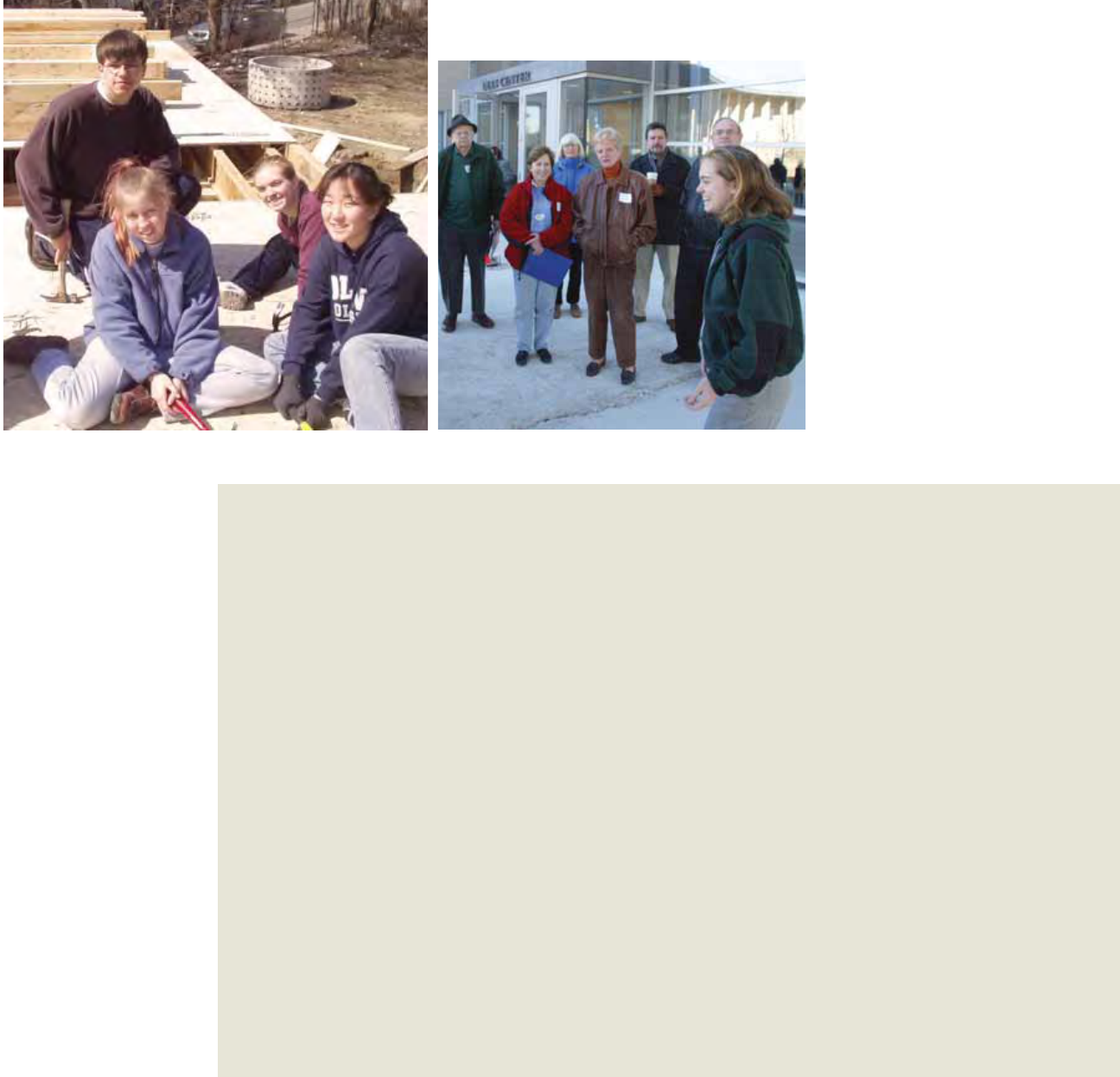
33
refurbishing computer equipment for use by
low-income students; conducting engineering
workshops or projects with the public schools;
and assisting at local service agencies.
Early cooperation and coordination between
Milas and the community helped to minimize
potential disruptions and find satisfactory solu-
tions to traffic and infrastructure issues. Olin staff
and students have made a deliberate effort to take
part in Needham’s community life, joining local
service clubs, town activities and volunteer
efforts. Throughout the building phase and Olin’s
first years, Needham has become increasingly
proud of being “America’s Newest College
Town.”
Needham resident Carol Johnson Boulris is a former member of Needham’s Town Meeting and the School Committee, and
current chair of the Historical Commission. Proving that the world is a small place, she grew up in Alton, Ill., the home base
of Olin Industries. In March 1998, she wrote a letter to the Needham Times, voicing support for the foundation’s plans and
sharing a remarkable encounter between her father and Franklin Olin. Excerpts from the letter are below.
To the Editor,
When I was a child in Alton, Illinois, my father J.B. Johnson was the town’s Superintendent of Schools. Nearby East Alton
was the home plant of the Olin Corporation....One Sunday afternoon, a uniformed chauffeur rang the front doorbell of our
home. He explained that elderly Mr. F. W. Olin wanted to speak to my father. Dad went out to the car to greet Mr. Olin so
that the old gentleman would not have to leave his car.
Returning to the house quite a while later, my father had a look of incredulity on his face. I remember my father’s words:
“Mr. Olin just asked if I would like him to give a vocational high school to the town!”
In time, the large brick F. W. Olin Vocational School was built on a rise between an existing junior high school and the
town’s senior high school, creating a campus-like complex on three small hills where thousands of students have traveled
back and forth among buildings as they received their education. In the Olin Building, as it was called, young people
were trained in occupations such as welding, practical nursing, printing, shop and carpentry, drafting, cosmetology, etc.
The school filled a great need in the community and enabled many young people to receive training for good jobs after
high school.
– Needham Times, March 19, 1998
Emma Goodman ‘06 (right)
leads a tour of the campus for
Needham residents.
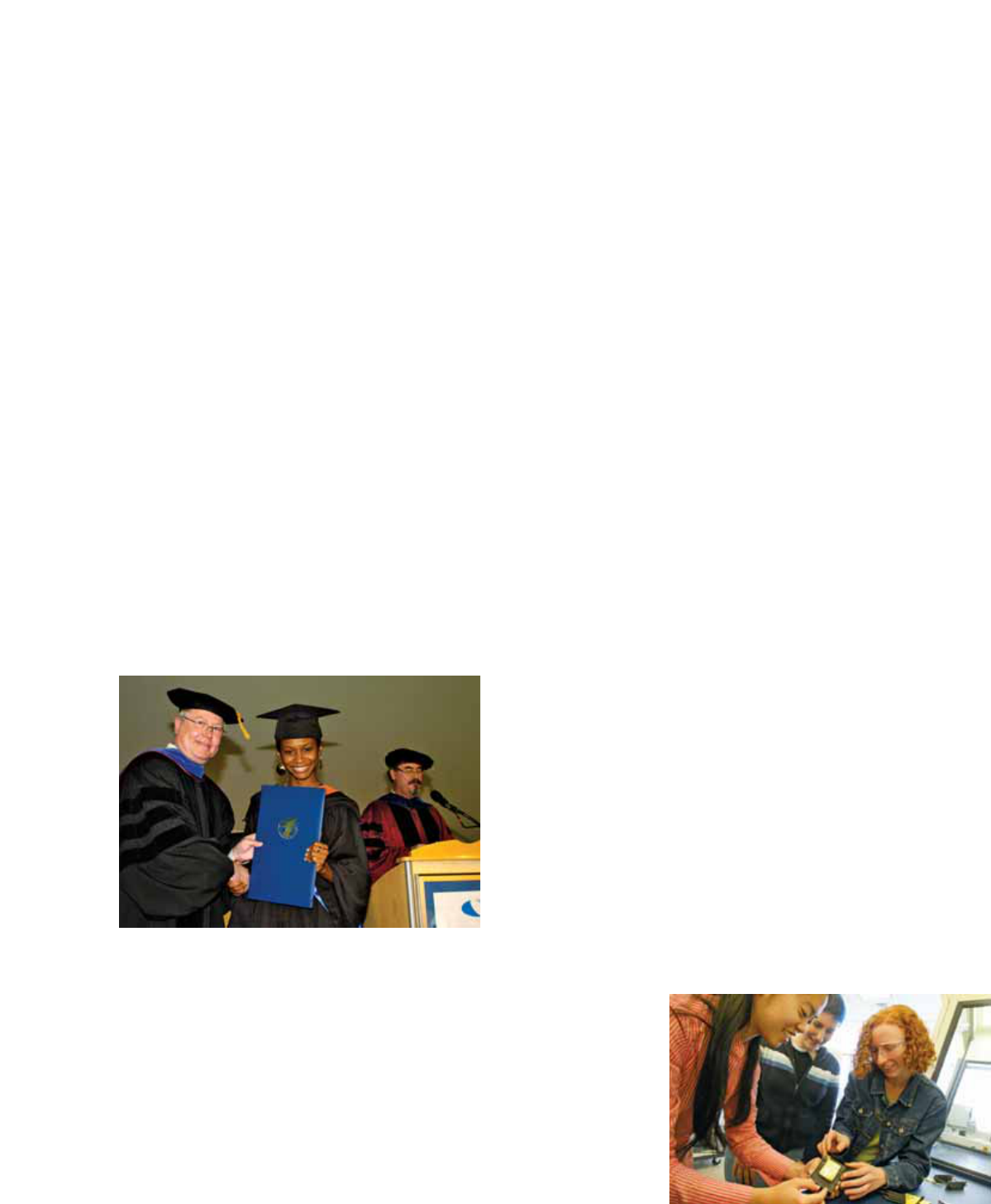
34
he graduation of the Class of 2006 signaled
the end of the “Invention” phase of Olin’s
history. That one afternoon encapsulated nine
years of constant effort by the trustees, the
administration, students and advisers. Much
of the collective attention was focused on this
milestone. The goal was achieved, but the work
did not stop.
In the same year as the first graduation, the
college received official word of its accreditation
by the New England Association of Schools &
Colleges (NEASC), the regional accrediting
body, followed shortly by accreditation by ABET,
the accreditor of college and university programs
in applied science, computing, engineering and
technology. The 2006 graduation was the last
substantial piece needed to secure Olin’s eligibili-
ty for accreditation by these two organizations.
The imprimatur of accreditation not only certi-
fies that the school is qualified to train engineers;
it also makes Olin and its graduates eligible for a
number of government, foundation and agency
programs that are closed to unaccredited institu-
tions.
Olin must find ways to address not only the
financial but also the human costs of “continual
innovation,” which can be high for an institution
with such ambitious goals as Olin. New ways
must be found to husband the college’s endow-
ment and to develop new revenue streams that
will uphold its financial assets. Sustainability must
become as important a mantra as Innovation.
Faculty members can now breathe a big sigh of
relief — the structure of the curriculum has been
completed and tested, and it is no longer neces-
sary to start everything from scratch. For them,
and for members of the administration, the chal-
lenge is to keep moving forward — not only to
fix the things that need fixing, or to expand
degree offerings, but also to maintain the culture
of innovation that is a founding precept of the
college. They must keep abreast of new develop-
ments in engineering and in business, and keep
devising ways to
meet these needs
without falling into
the dual traps of
complacency or
making changes for
change’s own sake.
And then there are
the students. Olin’s first few crops of graduates
have left the college. For now, the surest way for
What’s Next?
T
At Olin's first Commencement on May 21, 2006, graduate
Etosha Cave receives her diploma from Provost David
Kerns as Dean of Faculty Michael Moody looks on.
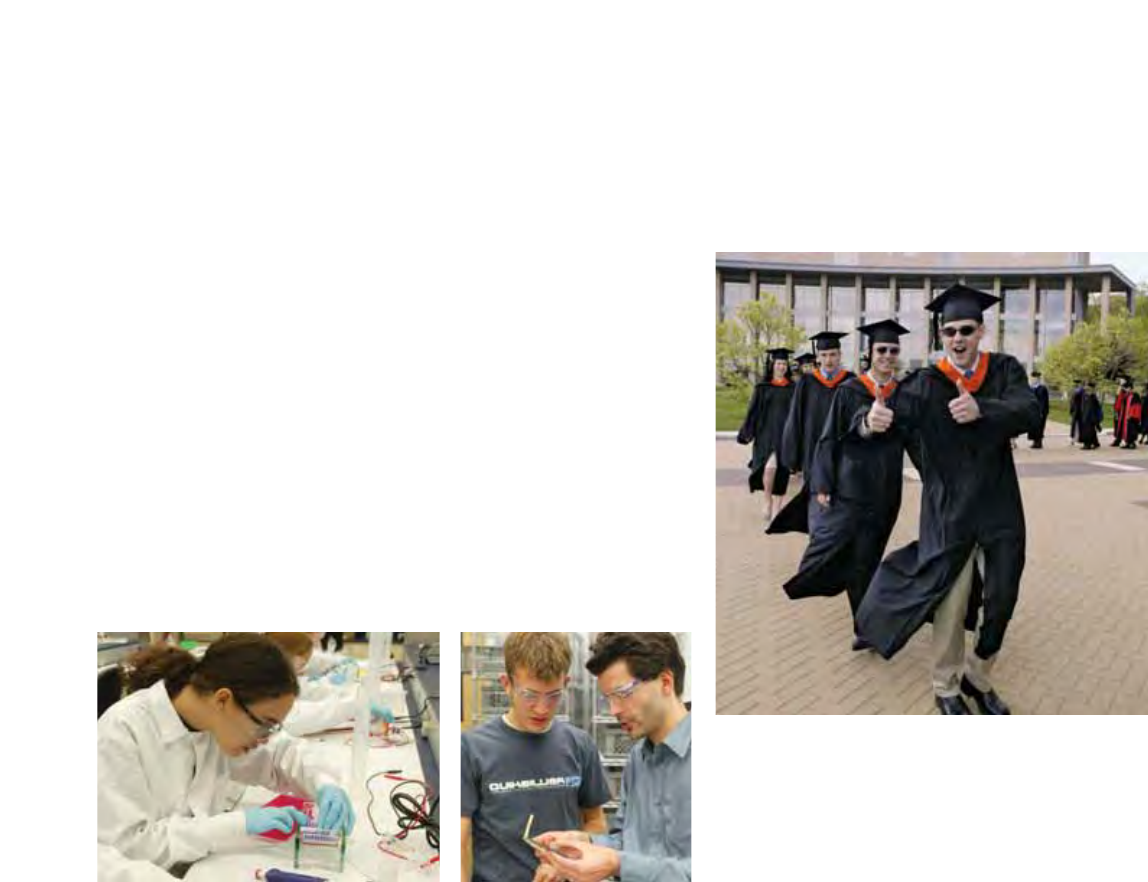
35
the college and the world to evaluate the success
of Olin’s innovative approach to education will
be to see the performance of its students as they
go on to graduate study or enter the workforce.
They are well able to bear this extraordinary bur-
den. Take it for granted that they are incredibly
smart. They have also shown themselves to be
adaptable and flexible, persistent, creative, and
idealistic.
Finally, there is the rest of the world. To create a
new teaching model for your students is a good
thing, but the goal of the Olin Foundation —
with the NSF and ABET — was to recraft the
entire process of engineering education. For the
Olin experiment to be truly successful, its inno-
vations must be adopted by other schools as well.
This has started to happen: Olin receives visitors
from around the globe who are interested in
learning about its innovative curriculum, and the
college has struck up a partnership with the
University of Illinois at Urbana-Champaign to
test whether its innovations can be scaled up to
a large public institution.
The road is long and not always smooth; each
new stage has its challenge. Nevertheless, new
travelers take to the road each year, sure that the
goal is worth the journey.
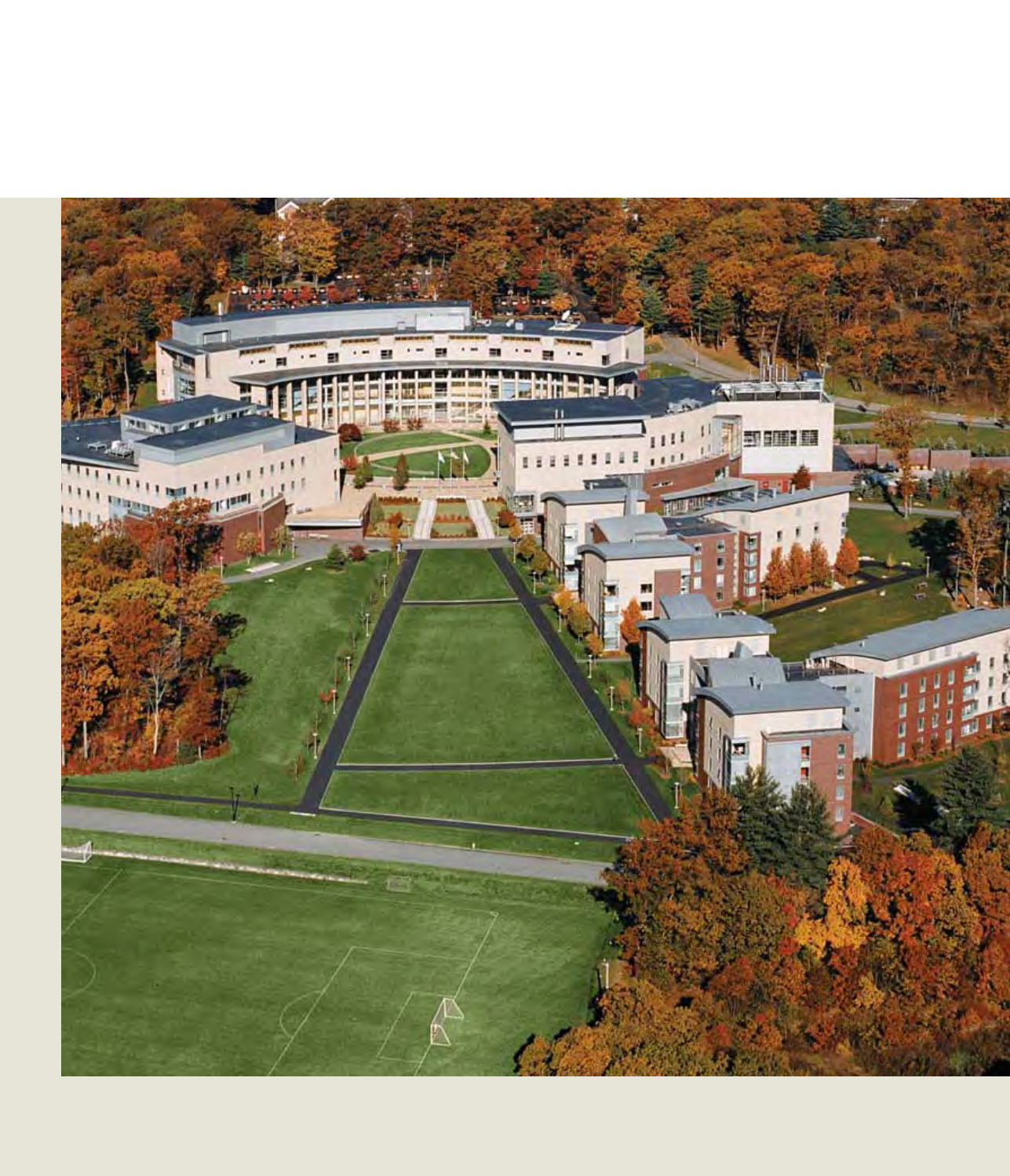
36

Many people in the Olin community have helped me with this project, providing resources,
sitting for interviews and setting up contacts. Obvious in all of them was an immense pride
in what they had accomplished together, gratitude that they had been a part of it, and a
great eagerness that I should understand just how unique and important the opportunity had
been. I do not think a single encounter went by without someone assuring me that it was a
“less-than-once-in-a-lifetime opportunity.” Many thanks to:
I would like to thank the members of the Needham community who were involved in the
early development of Olin College from the town side, for the information they provided.
By coincidence — or maybe not, Needham being a small place — they are all also currently
members of my Board of Directors at the Needham Historical Society. I would like to there-
fore thank them a second time, for their patience as I fit this project in between my histori-
cal society duties:
Lawrence Milas, President, Director,
F. W. Olin Foundation; member, Olin
College Board of Trustees
William Norden, Secretary and
Counsel, Director, F. W. Olin
Foundation; Chair, Olin College Board
of Trustees
William Horn, Director, F. W. Olin
Foundation; former member, Olin
College Board of Trustees (retired)
Richard K. Miller, President of the
College
David V. Kerns, founding Provost
Sherra E. Kerns, founding Vice
President for Innovation and
Research
Stephen Hannabury, Vice President
for Finance
Roger Crafts, Dean of Student Life
Duncan Murdoch, former Vice
President for External Relations and
Enrollment and Dean of Admission
Carla Gude, Olin College Trustee
C. Scott Gibson, Olin College Trustee
Robert N. McBurney, Olin College
Trustee
Lillian Wu, Olin President’s Council
Lynn Andrea Stein, Professor of
Computer and Cognitive Science
Mark Somerville, Associate Professor
or Electrical Engineering and Physics
Dianna Magnoni, Director, and the
Staff of the Olin College Library
Katherine Blazek, Class of 2006
William Clayton, Class of 2006
Adam Horton, Class of 2006
Grant Hutchins, Class of 2006
Leighton Ige, Class of 2006
Que Anh Nguyen, Class of 2006
Jeffrey Satwicz, Class of 2006
Polina Segalova, Class of 2006
Nicholas Zola, Class of 2006
Mallory (Mel) Chua, Class of 2007
Tiana Veldwisch, Class of 2008
Francys Scott, Class of 2009
Carol Johnson Boulris, Needham
Historical Commission (and former
resident of Alton, Ill.)
John H. Cogswell, Needham Board of
Selectmen
Mark Gluesing, former President,
West Needham Civic Association
Maurice Handel, Needham Planning
Board
Afterword and Acknowledgments
I would also like to thank Jeff Stern, who recorded all the interviews; photographer Michael
Maloney; and the talented Sylvia Peretz of Peretz Design, for her design of this volume.
Finally, and most of all, I would like to thank Joe Hunter, Olin’s director of communication,
for the huge amount of effort that he expended on this project. Joe set the project in motion
and faithfully (and tactfully) pushed it along the whole route, providing me with every
resource and making every logistical arrangement. Working with him was a pleasure, and I
am unspeakably grateful. As in all my endeavors, thanks to my family — my husband, Michael
Greis, and my children, Madeleine and Adam — for their love and cheerleading.
Congratulations to the Olin College Classes of 2006, 2007, 2008 and 2009, and to the
parents, administrators, advisers and teachers who helped bring them to their Graduation
Day. Best wishes to all the Olin students for whom this milestone is yet to come.
Gloria Polizzotti Greis
Executive Director, Needham Historical Society
June 2009

38
Appendix A
Statement of Founding Precepts for Franklin W. Olin
College of Engineering
The F. W. Olin Foundation, Inc., founded in 1938 in New York by Franklin W. Olin, established
the Franklin W. Olin College of Engineering in Needham, Massachusetts, in 1997. In connec-
tion with the execution of an agreement between the Foundation and the College of event
date herewith, which, among other matters, provides for the Foundation to make endowment
and other grants to the College, the Foundation hereby sets forth the following precepts,
all of which the College accepts and agrees to adhere to and abide by in perpetuity. These
precepts reflect the principles upon which the College was established as well as the
Foundation’s hopes for what the College will accomplish and the good that it will do.
With respect to the Foundation’s reasons for establishing the College, let it be said that the
Foundation does not seek to establish a generic undergraduate engineering college — one
that will simply offer programs similar to many others around the country. Olin College is
intended to be different — not for the mere sake of being different — but to be an important
and constant contributor to the advancement of engineering education in America and
throughout the world and, through its graduates, to do good for humankind.
1. Name of the College
The College shall, in perpetuity, be named FRANKLIN W. OLIN COLLEGE OF ENGINEERING, or
in the event it shall be determined upon the written consent of two-thirds of the total num-
ber of the members of the College’s Board of Trustees that such name is no longer adequate-
ly descriptive of the College’s programs and courses of study, such name may be changed,
provided, however, that: (1) the College’s name always shall include the name “Franklin W.
Olin”; and (2) no other person’s name (or corporate or business name) shall appear in the
name. It is also agreed that for marketing and related purposes, the name “Olin College” (or
appropriate variations such as “Olin University” and “Olin School”), may be used in written
material, provided that when practical there will always appear in such materials a reference
to the College’s full name.
2. Engineering the Primary Academic Program
The College’s primary academic program always will be undergraduate engineering. As such,
the number of its full-time-equivalent (herein “FTE”) students working toward an undergrad-
uate engineering degree shall always constitute no less than two-thirds of the total FTE
undergraduate enrollment.
3. Commitment to Academic Quality and Diversity
Students shall be recruited on the basis of their academic merit, as determined by their
scholastic records and appropriate test results, and other relevant achievements. However,
from among the students who qualify on this basis, the College shall endeavor to develop as
diverse a student community as is possible. Diversity of many kinds is desirable. Race, gender,
creed, religion, ethnicity, economic background, home location, particular skills, talents and
experiences are but a few that are important for achieving a diverse and vital student com-
munity. Quality and diversity also shall be sought with respect to the College’s faculty and
administrative employees. Because current pedagogy makes a low student/faculty ratio an
important contributing factor for achieving academic quality, the College will maintain a low
student/faculty ratio of about ten to one unless changes in pedagogy through technological
developments or other improvements in education are developed which justify departing
from this standard.

39
4. A Culture of Innovation and Constant Improvement
The National Science Foundation and other credible voices from engineering schools and
industry have advocated changes in how engineers are educated. Some of the major themes
of the changes advocated include interdisciplinary and integrated teaching, hands-on learn-
ing and research opportunities for students, improved communication skills, students working
as members of teams (the way that engineers in industry work), exposure to other cultures or
an international experience, and a better understanding of business and management prac-
tices. But for many reasons, including the very simple reason that many, but not all, faculty
are resistant to change, progress has been slow and disappointing. The Foundation’s decision
to establish the College was based in large part on a determination that the need to reform
engineering education could be accomplished more easily at a new institution that was not
burdened with people and existing programs resistant to change. However, even a new insti-
tution can, with the passage of time, become resistant to change. If this were to happen at
the College, it would be a tragic loss of opportunity for engineering education, generally, and
a terrible disappointment to the Foundation. The need for the College to be continually open
to change and to encourage and support a culture of innovation is paramount. Risk-taking
with respect to new programs or the manner in which engineers are taught should be rou-
tine. The College acknowledges that a culture of innovation is a fundamental precept of the
planning for Olin College. The College commits itself to the need to be open to change and
to support a culture of innovation and constant improvement in every aspect of its opera-
tions and programs.
5. A Student-Centered and Philanthropic Institution
The Foundation believes that the College must care about its students not only as scholars
and engineers but also as people. Students must be encouraged and given the opportunity to
grow both intellectually and socially. Student life policies must assure that no student is for-
gotten or ignored. A commitment to support the education of students with programs in the
arts, humanities and social sciences is vital to the fulfillment and potential of their lives. The
College also should nurture a student’s appreciation of the role of philanthropy in America.
Students should be encouraged to contribute their time and wealth to support philanthropic
endeavors of their choice. The College itself, the product of philanthropy, should find ways to
contribute to its community, and beyond, with services natural for it as an educational insti-
tution. Policies must be maintained that support these outcomes.
6. Full-Tuition Scholarships
The College will always endeavor to operate by offering full-tuition scholarships to all regular
full-time students enrolled in its undergraduate degree programs. The solicitation of addi-
tional endowment gifts and annual giving to support tuition and scholarship aid shall be an
important goal. In order to provide full-tuition scholarships to all students, the College shall
adjust its undergraduate enrollment to a number that can be supported by the projected
operating budget revenue. Beginning in the 2021 academic year, upon the written consent
of ninety percent of the total number of the members of the College’s Board of Trustees, the
College may elect to reduce full-tuition scholarships to an amount that will leave the portion
of tuition payable by regular full-time students enrolled in its undergraduate degree pro-
grams equal to an amount that is not in excess of the average cost of tuition for resident
engineering students at the following institutions: the University of California — Berkeley,
the Georgia Institute of Technology, the University of Illinois — Urbana, the University of
Massachusetts — Amherst, the University of Michigan — Ann Arbor and the University of
Texas — Austin. The decision to reduce full-tuition scholarships shall be based on substantial
business needs and a determination that the endowment take and other revenue cannot sup-
port the number of students needed to sustain the College’s academic programs. During such

40
period of time as the College shall only offer partial scholarships, the College may award
financial aid to students based on need. After reducing full-tuition scholarships, the College’s
Board of Trustees may thereafter, by a simple majority vote, at a meeting of the Board called
for such purpose, restore full-tuition scholarships. Tuition scholarships, whether they fully or
only partially cover tuition, always shall be awarded to all students who are admitted to the
College regardless of need. This Precept shall not prohibit the College from charging for or
providing need-based aid for non-tuition charges such as room, board and student fees.
7. Collaboration With Babson College
The conceptual planning for Franklin W. Olin College of Engineering made collaboration with
Babson College an important element. Babson’s recognized excellence in management and
entrepreneurship education were considered to be potential resources for the College’s own
innovative programs. The College shall endeavor to always work closely with Babson College
to develop programs and operating and administrative procedures for their mutual benefit.
Similar collaboration with other neighboring colleges, particularly Brandeis University and
Wellesley College, shall be actively sought.
8. Faculty Tenure
Knowledge of science and technology is not static but is continually evolving. The ability of
the College to offer its students a faculty that is competent in the latest advances in knowl-
edge and in newly emerging fields of science and technology is absolutely essential to the
College’s goal of offering academic programs with the highest possible quality. The College
will, therefore, strive to strike an appropriate balance between the legitimate concerns of
faculty for employment security and the College’s need to achieve and maintain the quality
it seeks. It will do this without offering traditional tenure.
9. College to Remain Independent
The College shall remain a privately supported institution committed to supporting itself
from private, rather than government or public resources. However, government grants from
programs subject to peer review and open to other institutions on a competitive basis may
be sought. Grants from so-called earmarked funds will be rejected.
10. Economic and Governmental Ideals
The College’s policies and operations shall be consistent with and supportive of free enter-
prise and a capitalistic economy within a democratic nation.

41
Founding Faculty
Olin’s founding faculty members joined the college in the fall of 2000. An intrepid group
every bit as risk-taking as Olin’s first students, they came from the nation’s top schools.
They arrived on a campus not yet built, accepted positions that didn’t offer tenure, and
eagerly took on the task of giving form to a curriculum that aimed to revitalize engineering
education and educate the best students. They more than rose to the challenge. Here, in
alphabetical order, are Olin’s founding faculty, with the titles they held upon their arrival:
Appendix B
Dr. Hillary Berbeco, Assistant
Professor of Chemistry
Dr. John Bourne, Professor of
Electrical and Computer Engineering
Dr. Diana Dabby, Assistant Professor
of Electrical Engineering and Music
Dr. Daniel Frey, Assistant Professor of
Mechanical Engineering
Dr. Stephen S. Holt, Professor of
Physics
Dr. David V. Kerns, Jr., Franklin and
Mary Olin Distinguished Professor of
Electrical Engineering, Provost
Dr. Sherra E. Kerns, F. W. Olin
Professor of Electrical and Computer
Engineering, Vice President for
Innovation and Research
Dr. Joanne C. Pratt, Assistant
Professor of Biological Sciences
Dr. Lynn Andrea Stein, Professor of
Computer and Cognitive Science
Dr. Brian D. Storey, Assistant
Professor of Mechanical Engineering

Articles and Publications
1951 Press Release re Franklin W. Olin. Public Relations Division, Olin Industries Inc., East
Alton, Ill. [Biographical information, on the occasion of his death, c. May 1951.]
1953 “The $50 Million Santa Claus.” Fortune, December 1953.
1990 The First 50 Years. The F. W. Olin Foundation, Inc. Privately printed. With an ms.
addendum, “Supplement to ‘The First 50 Years,’” June 1997.
1997 “NYC Foundation to Spend $200 Million to Build a College from Scratch.”
Associated Press, 5 June 1997.
1997 “Largest Gift Ever Endows a New College.” William Honan. New York Times,
6 June 1997.
1997 “College Town?” Larry Bean. Needham Times, 12 June 1997.
1997 “New College a Boon for State.” Editorial, Quincy Patriot Ledger, 13 June 1997.
1997 “Neighborhood Group to Monitor College Plans.” Larry Bean. Needham Times,
17 July 1997.
1997 “Don’t Just Say No to Plans for College.” Editorial, Needham Times, 17 July 1997.
1997 “Petition to the [MA] Board of Higher Education, pursuant to 610 CMR 2.00 (Degree
Granting Regulations for Independent Institutions of Higher Education),” Lawrence
W. Milas, William J. Schmidt, William B. Norden and William B. Horn as
Incorporators, 6 October 1997.
1997 “Selling the ‘College Town.’” Jim Walker. Wellesley Townsman, 13 November 1997.
1997 Letter from Stanley Z. Zoplik (Chancellor, Board of Higher Education) to Lawrence
W. Milas (President, F. W. Olin Foundation, Inc.) notifying the Foundation of
approval of its petition, 18 November 1997.
1997 Letter from Stanley Z. Zoplik (Chancellor, Board of Higher Education) to Yvonne
Ellison (Corporate Input Section, Office of the [MA] Secretary of State) notifying
the secretary of state’s office of the board’s approval of the Olin Foundation’s
petition, 18 November 1997.
1998 “Olin College Coordinating Committee Formed.” Dave Gershman. Needham Times,
5 February 1998.
1998 “Business Owners Hear About College Benefits.” Dave Gershman. Needham Times,
12 March 1998.
1998 “Officials, Residents Urged to Welcome Olin College to Town.” Letter to the Editor,
Carol J. Boulris. Needham Times, 19 March 1998.
1998 “Olin Neighbors Looking for Answers.” Brian Sullivan. Needham TAB, 23 April 1998.
1998 “Olin Buildings to Be Far From Street.” Brian Sullivan. Needham TAB, 30 April 1998.
1998 “College Design to Shape Academic, Social Life.” Dave Gershman. Needham Times,
10 September 1998.
1998 “TM Raises Height Limit for College Buildings.” Dave Gershman. Needham Times,
19 November 1998.
1998 “Projects Give a Lesson in Accord.” Dave Gershman. Needham Times, 25 November
1998.
42
Sources

43
1998 “Well-Educated Bricklayers?” Carl Irving. Crosstalk (Higher Education Policy
Institute). Winter 1998 (Vol. 6, No. 1), pp. 2-4.
1999 “A Brief History of Wellesley.” Beth Hinchliffe. The Official Town of Wellesley
Website. www.ci.wellesley.ma.us/history/. c.1999.
2000 “Creating a Masterpiece at Olin College.” Alvin Sanoff. Prism, September 2000,
pp. 20-24.
2001 “Olin Puts Up $500 Million for a ‘No-Excuses’ College.” Jeffrey Mervis. Science,
Vol. 291 (9 March 2001), pp. 1886-1889.
2001 “Olin’s History.” Olin Online, Olin Corporation. www.olin.com/about/history.asp. Last
updated 13 July 2001.
2001 “Recruited Elite Will Engineer a New School.” David Abel. The Boston Globe,
22 August 2001.
2001 “A First-Class Partnership.” Alvin Sanoff. Prism, September 2001, pp. 1-4.
2001 “Engineering with a Creative Edge.” IEEE Spectrum, September 2001.
2002 “Starting with a Clean Slate.” Mark Clayton. Christian Science Monitor, 5 February
2002.
2002 “New College Is a True Feat of Engineering.” Mary Beth Marklein. USA Today,
19 August 2002.
2003 “Engineers for all Seasons.” Alvin Sanoff. Prism, January 2003, pp. 31-33.
2003 “Clean Slates and No Life Jackets.” Lisa Cervini. Design News, 22 September 2003.
2003 Perry Dean Rogers | Partners. http://perrydeanrogers.com. Last modified 5 December
2003.
2004 “If I’m Happy, Can This Be EE School?” Charles J. Murray. EE Times, 30 August 2004.
2004 “Campus Embraces Bold Thinking.” David Eisen. Boston Herald, c. 2004.
2005 “A Thumbnail Sketch of Needham’s History.” Gloria Polizzotti Greis. Needham
Historical Society. http://greisnet.com/needhist.nsf/Thumbnail%20of%20
Needham%20History!OpenPage.
2005 “Bent Out of Shape: Where is Olin’s Curved Bat?” Stephen Eschenbach. Cornell
Alumni Magazine, May/June 2005.
2005 “Building a Better Engineer.” David Wessel. The Wall Street Journal, 20 August
2005.
2006 “Frank Olin.” Baseball-reference.com. www.baseball-reference.com/o/olinfr01.shtml.
Literature Produced by the Franklin W. Olin College
of Engineering
1999 “You Can’t Get Into Our College…” Brochure, Office of Admission.
2000 “7 Reasons You Should Apply to an Engineering College That Doesn’t Exist.”
Brochure, Office of Admission.
2000 “When Friends Ask, ‘Where Are You Going to College?...‘ ” Brochure, Office of
Admission.

2000 “Invention 2000.” Richard K. Miller, David V. Kerns, Sherra E. Kerns.
www.olin.edu/about_olin/docs/invention2kf.asp.
2001 “Fearless?” Brochure, Office of Admission.
2001 “Student Approved.” Prospectus, Office of Admission.
2001 “Olin College and the Future of Engineering.” Richard K. Miller. “Future Synch,” Olin
College, 16 October 2001. www.olin.edu/about_olin/docs/future_of_engineering.asp.
2001 “From the Ground Up: Building a New Approach to Engineering Education.”
Brochure, Office of Corporate Relations.
2001 “Needham: America’s Newest College Town.” Brochure, Office of Admission.
2001 “The Olin College Curriculum Vision, Fall 2001.” David V. Kerns.
www.olin.edu/academics/curriculum/vision.asp.
2002 “Statement of Founding Precepts for Franklin W. Olin College of Engineering.”
F. W. Olin Foundation. www.olin.edu/about_olin/docs/founding_precepts.asp.
2004 “Designing from a Blank Slate — The Development of the Initial Olin College
Curriculum.” Sherra E. Kerns, Richard K. Miller, David V. Kerns.
2002 “Profile: Class of 2006.” Brochure, Office of Admission.
2002 “Olin College At a Glance: Class of 2006.” Brochure, Office of Admission.
2003 “Olin College At a Glance: Class of 2007.” Brochure, Office of Admission.
2003 Olin Rising. Program of the Inaugural Ceremonies, 3 May, 2003.
2004 “The Renaissance-Disruptive-Entrepreneurial-Inventive-Broad-Based-Socially-
Conscious-Big-Picture-Terrifically-Useful-Committed-High-Performing Olin
Engineer.” Prospectus, Office of Admission.
2004 “Olin College At a Glance: Class of 2008.” Brochure, Office of Communication.
2005 “Olin College At a Glance: Class of 2009.” Brochure, Office of Communication.
2005 “About Olin: Olin History.” F. W. Olin College of Engineering.
www.olin.edu/about_olin/olin_history_detail.asp.
Interviews
44
Lawrence Milas, 8 May 2005
William Norden, 8 May 2005
William Horn, 27 September 2005
Richard K. Miller, 28 July 2005 and
10 August 2005
David V. Kerns, 19 July 2005
Sherra E. Kerns, 29 June 2005
Stephen Hannabury, 18 July 2005
Roger Crafts, 15 July 2005
Duncan Murdoch, 28 September
2005
Joseph Hunter, 8 August 2005
Carla Gude, 12 October 2005
C. Scott Gibson, 20 September 2005
Robert N. McBurney, 17 October
2005
Lynn Andrea Stein, 16 August 2005
Mark Somerville, 29 September 2005
Adam Horton, 30 September 2005
Leighton Ige, 30 September 2005
Que Anh Nguyen, 30 September
2005
Polina Segalova, 30 September 2005
Jeffrey Satwicz, 3 October 2005
Mallory (Mel) Chua, 3 October 2005
Tiana Veldwisch, 3 October 2005
Francys Scott, 3 October 2005

45
1
“The $50 Million Santa Claus,” Fortune, December 1953.
2
Press Release re Franklin W. Olin. Public Relations Division, Olin Industries Inc., East Alton,
Ill. May 1951.
3
The First 50 Years. The F. W. Olin Foundation, Inc. Privately printed, 1990.
4
Lawrence W. Milas, Interview, 8 May 2005.
5
“Well-Educated Bricklayers?” Carl Irving, Crosstalk, Winter 1998.
6
“Olin College and the Future of Engineering,” Richard K. Miller, October 2001; Interview,
10 August 2005.
7
“Well-Educated Bricklayers?” Carl Irving. Crosstalk, Winter 1998.
8
“Petition to the [MA] Board of Higher Education, pursuant to 610 CMR 2.00 (Degree
Granting Regulations for Independent Institutions of Higher Education),” Lawrence W.
Milas, William J. Schmidt, William B. Norden and William B. Horn as Incorporators,
6 October 1997.
9
Letter from Stanley Z. Zoplik (Chancellor, Board of Higher Education) to Lawrence W. Milas
(President, F. W. Olin Foundation, Inc.) notifying the Foundation of approval of its petition,
18 November 1997.
10
Henry David Thoreau, Walden.
11
Richard K. Miller, Interview, 10 August 2005.
12
“Selling the ‘College Town.’” Jim Walker. Wellesley Townsman, 13 November 1997;
“Business Owners Hear About College Benefits.” Dave Gershman. Needham Times,
12 March 1998.
Endnotes

Nondiscrimination Statement
Olin College does not discriminate in admission,
employment or other college-administered programs on
the basis of race, color, creed, national or ethnic
origin, gender, religion, disability, age, sexual
orientation, or veteran, marital or citizenship status.

FROM THE GROUND UP THE FOUNDING AND EARLY HISTORY OF THE FRANKLIN W. OLIN COLLEGE OF ENGINEERING
Table Of Contents
1 Preamble
3 Founding Inspiration: Franklin W. Olin
6 The F. W. Olin Foundation
10 The Big Idea
19 The-Less-Than-Once-in-a-Lifetime-Opportunity
27 Building the Plane As It’s Flying
31 Needham: America’s Newest College Town
34 What’s Next?
37 Afterword and Acknowledgments
38 Appendix A: Statement of Founding Precepts
41 Appendix B: Founding Faculty
42 Sources
45 Endnotes
Franklin W. Olin College of Engineering Olin Way Needham, Massachusetts www.olin.edu
From The Ground Up
The Founding and Early History of the Franklin W. Olin College of Engineering
A Bold Experiment in Engineering Education
This book has been printed on paper certified
by SmartWood to the Forest Stewardship
Council (FSC) standards, indicating the trees
are grown in responsibly managed forests.
The majority of the pulp is from eucalyptus
trees, which mature in six to eight years,
replenishing the forests quickly.

FROM THE GROUND UP THE FOUNDING AND EARLY HISTORY OF THE FRANKLIN W. OLIN COLLEGE OF ENGINEERING
Table Of Contents
1 Preamble
3 Founding Inspiration: Franklin W. Olin
6 The F. W. Olin Foundation
10 The Big Idea
19 The-Less-Than-Once-in-a-Lifetime-Opportunity
27 Building the Plane As It’s Flying
31 Needham: America’s Newest College Town
34 What’s Next?
37 Afterword and Acknowledgments
38 Appendix A: Statement of Founding Precepts
41 Appendix B: Founding Faculty
42 Sources
45 Endnotes
Franklin W. Olin College of Engineering Olin Way Needham, Massachusetts www.olin.edu
From The Ground Up
The Founding and Early History of the Franklin W. Olin College of Engineering
A Bold Experiment in Engineering Education
This book has been printed on paper certified
by SmartWood to the Forest Stewardship
Council (FSC) standards, indicating the trees
are grown in responsibly managed forests.
The majority of the pulp is from eucalyptus
trees, which mature in six to eight years,
replenishing the forests quickly.
